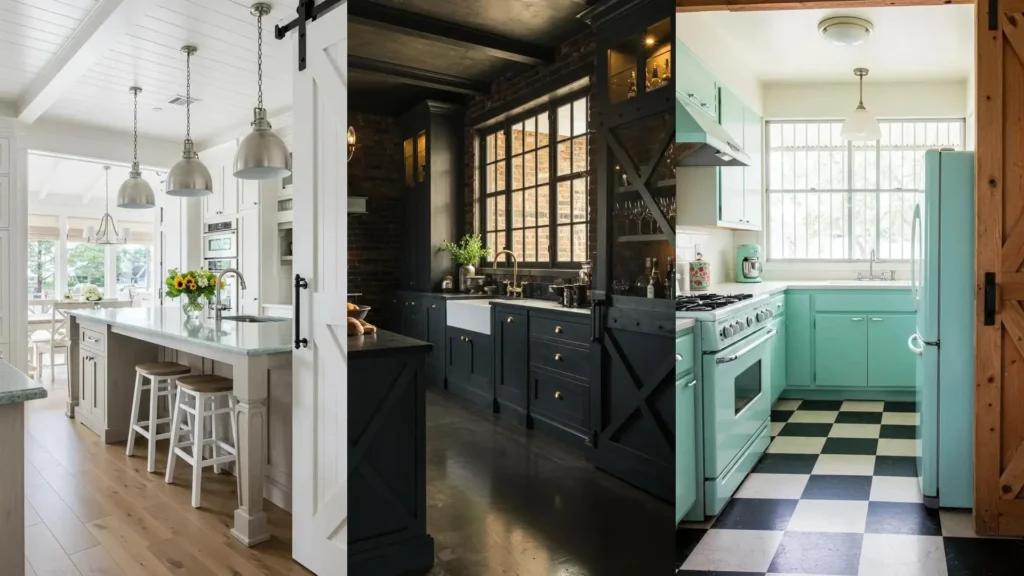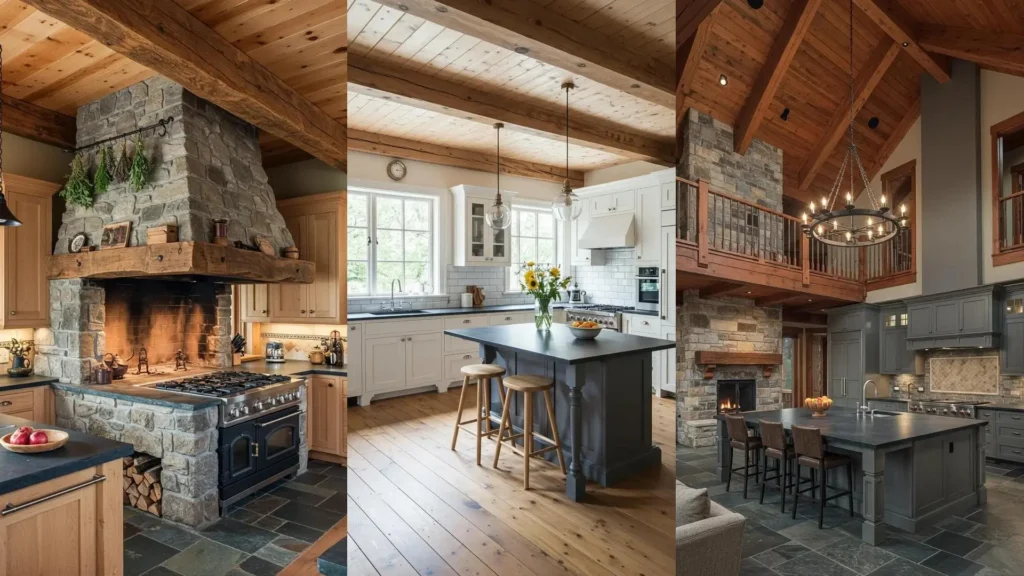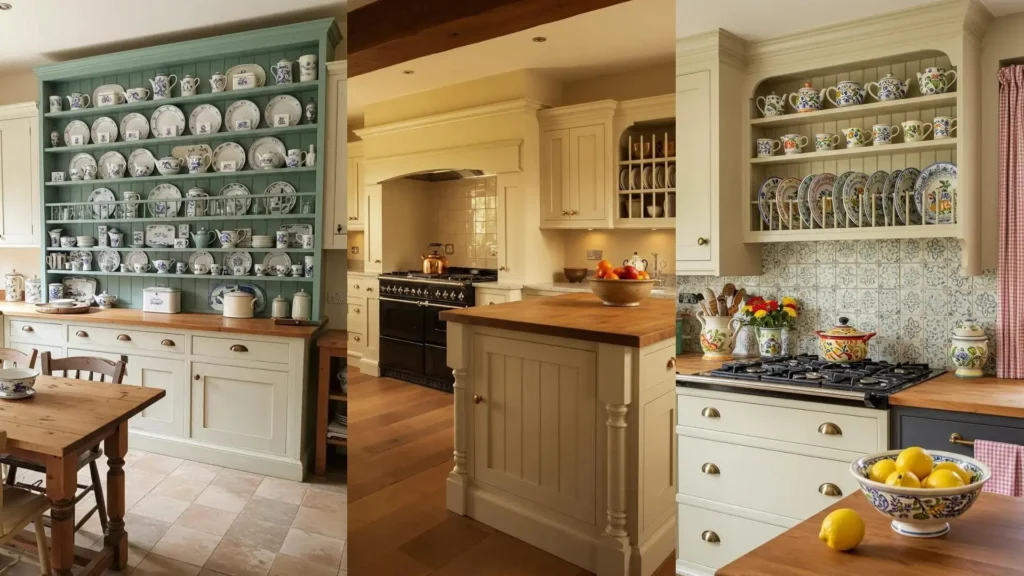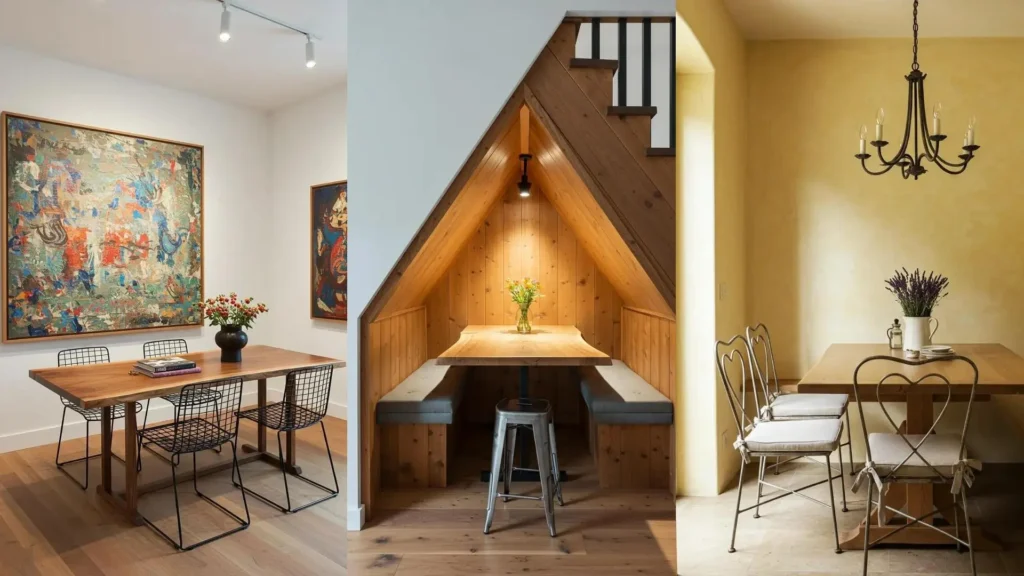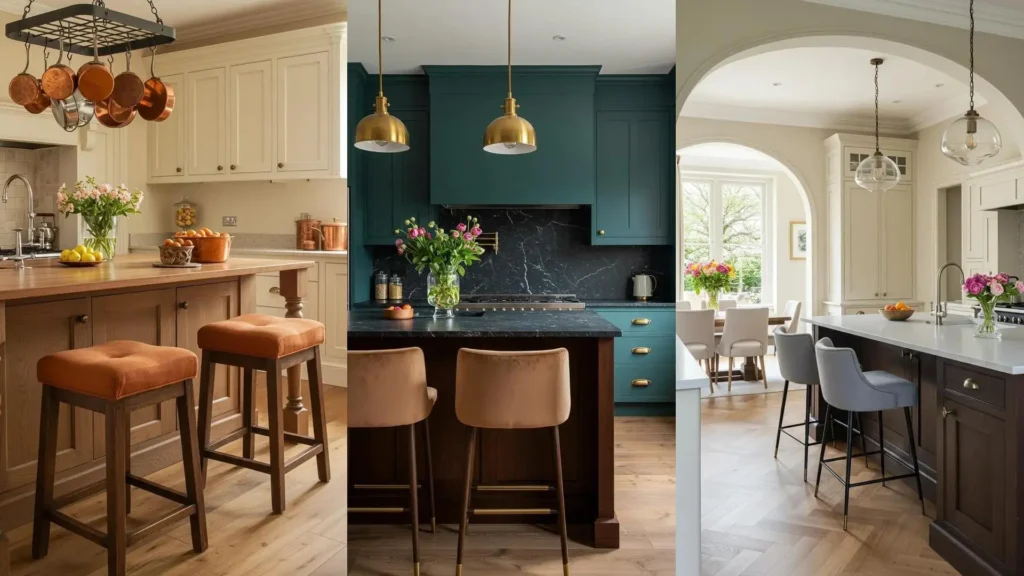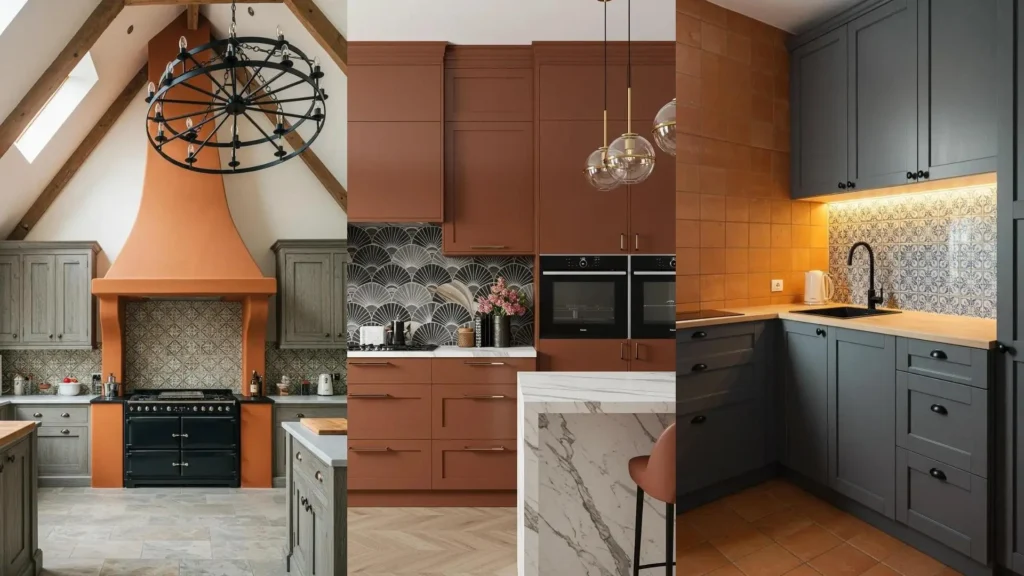The beauty of a farmhouse-industrial kitchen lies in its elegant tension—the meeting of raw, functional materials with warm, rustic comfort.
You may feel drawn to the strength of steel-framed windows and the honesty of a sliding barn door, yet wonder how to keep the space from feeling cold or impersonal.
The secret is in the balance. It’s about learning where to add softness, which textures to contrast, and how to use color to guide the eye and ground the room.
Here, we’ll move beyond fleeting trends to explore specific, actionable ways you can create a kitchen that is both a hardworking hub and a place of soulful beauty.
1. Ground Your Space with a Single Color Accent
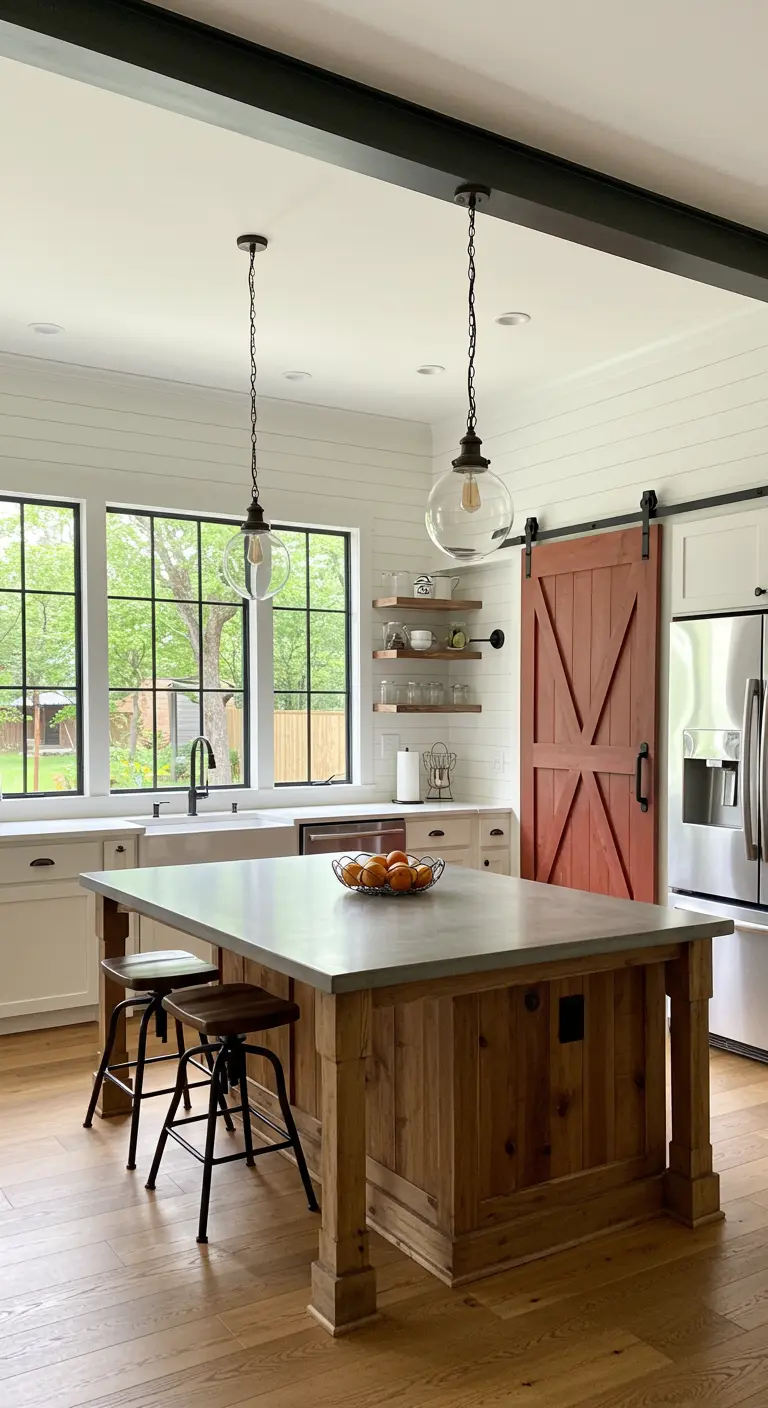
In a neutral kitchen, a single, decisive pop of color on a functional element, like this terracotta-red barn door, creates an immediate focal point.
This strategy adds personality without requiring you to commit to a full-color palette on walls or cabinetry.
If red feels too bold, consider a deep forest green, a saturated navy, or a sophisticated charcoal gray to achieve the same anchoring effect.
The key is to repeat this accent color in very small doses elsewhere—perhaps in a ceramic bowl or a piece of art—to create a sense of intention.
2. Embrace a Moody, Monochromatic Palette
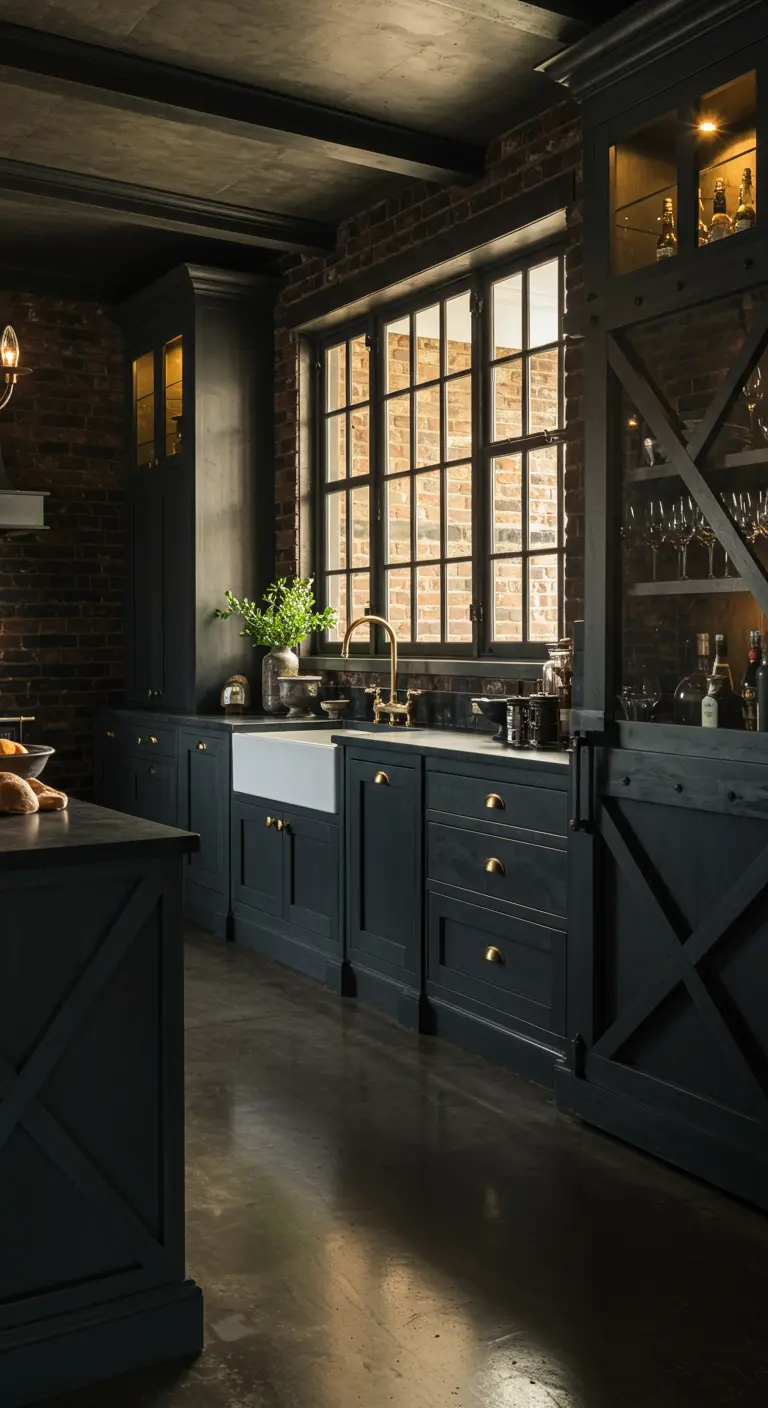
Do not be afraid of dark, enveloping color, even in the kitchen.
Here, matte black cabinets, an exposed brick wall, and dark flooring create a sophisticated, cocooning effect that feels incredibly chic.
To prevent the space from feeling heavy, ensure ample natural light from large, steel-framed windows and introduce reflective surfaces.
Warm brass hardware and focused interior cabinet lighting add a layer of golden light that breaks up the darkness and highlights your favorite glassware.
This approach transforms the kitchen into an intimate, elegant hub, perfect for evening entertaining.
3. Mix Raw Materials for Textural Interest
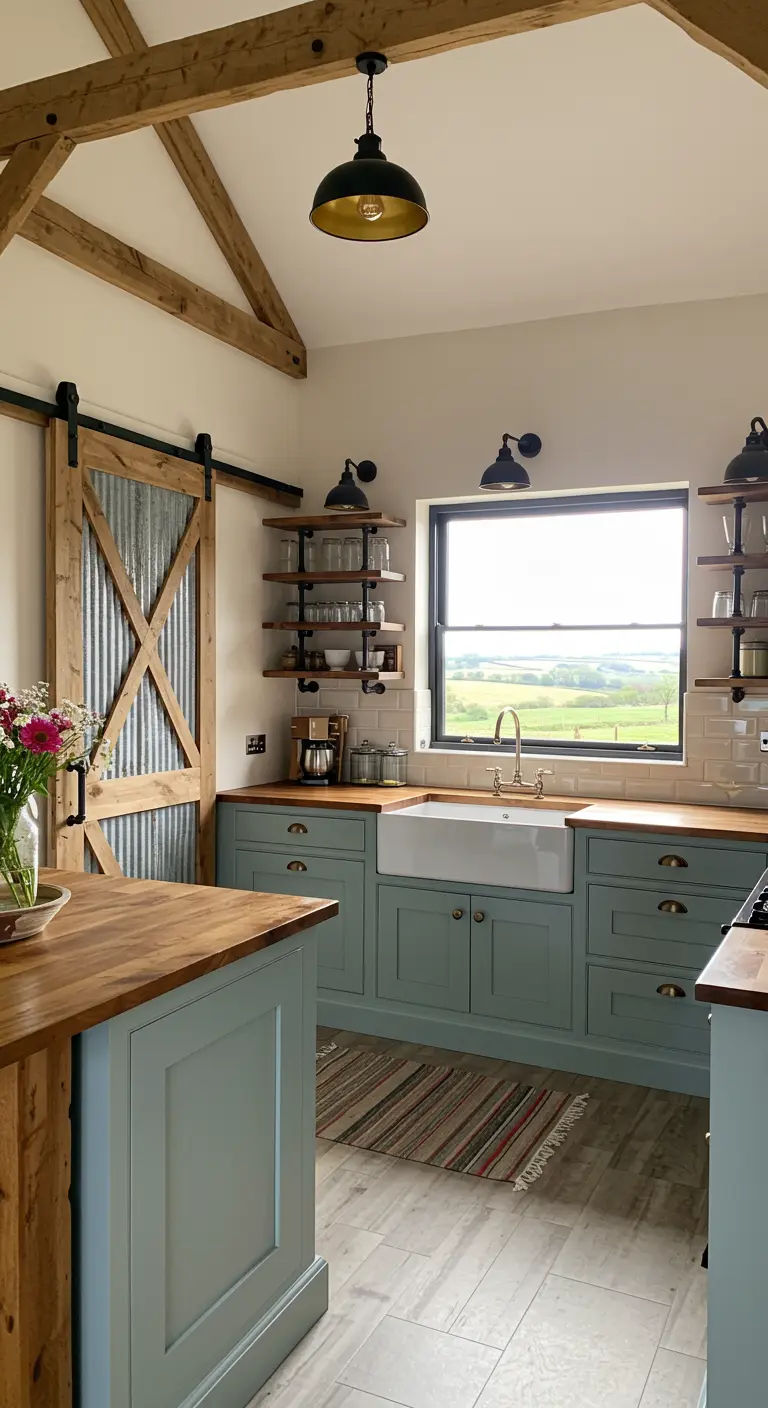
Elevate the classic barn door by introducing an unexpected material, like the corrugated metal panel seen here.
This simple addition instantly adds an industrial edge that contrasts beautifully with the warm wood frame and smooth, painted cabinets.
You can achieve this by sourcing panels from a hardware store or looking for reclaimed materials for a more authentic, weathered look.
Pairing this rustic-industrial feature with soft sage green cabinetry creates a perfect balance between hard and soft, old and new.
4. Unify Open Spaces with Consistent Finishes
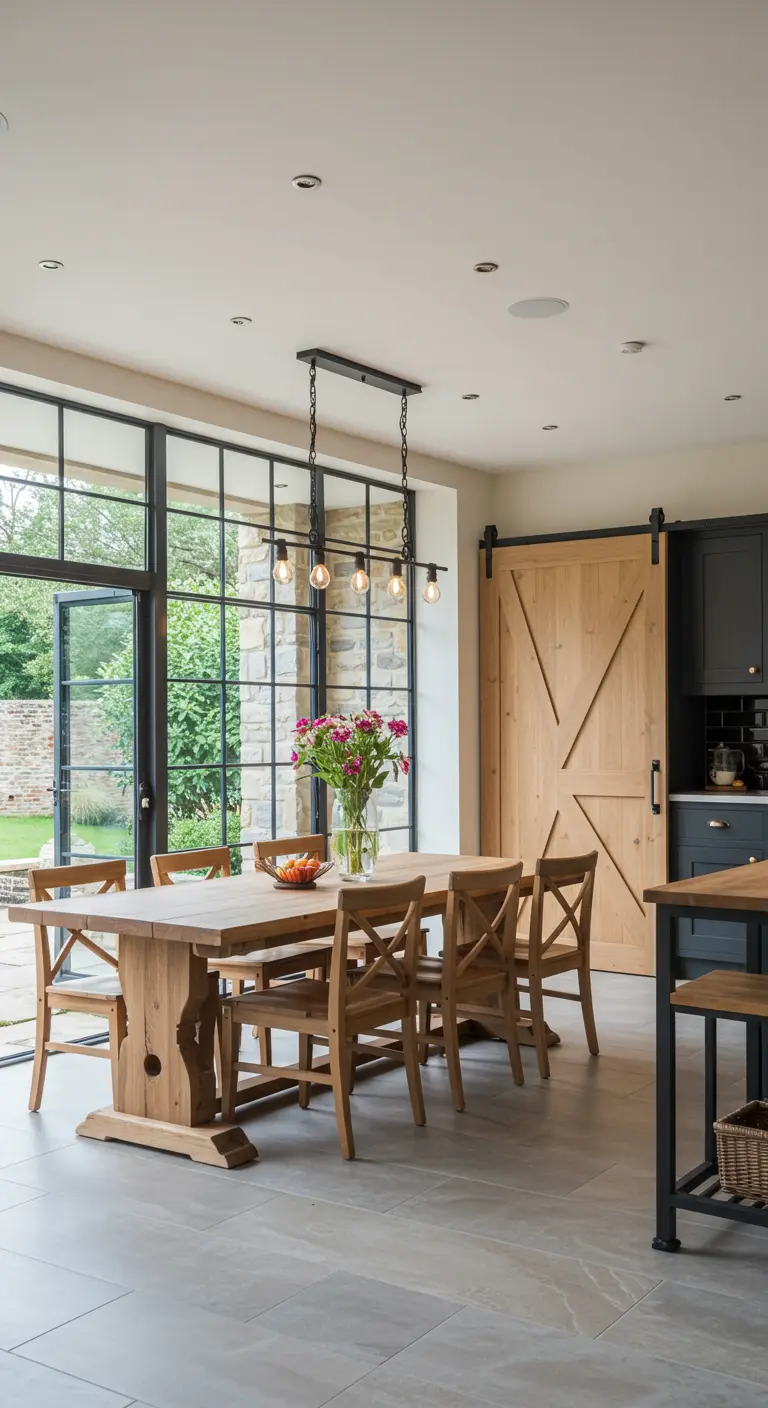
In an open-concept kitchen and dining area, create a cohesive flow by repeating key materials across both zones.
Notice how the black steel of the patio doors is echoed in the barn door hardware and the linear light fixture over the table.
Similarly, the warm, natural oak of the dining table and chairs harmonizes with the finish of the barn door.
This intentional repetition creates a seamless visual journey, making the two distinct areas feel like one unified, thoughtfully designed space.
5. Use a Barn Door to Maximize Narrow Spaces
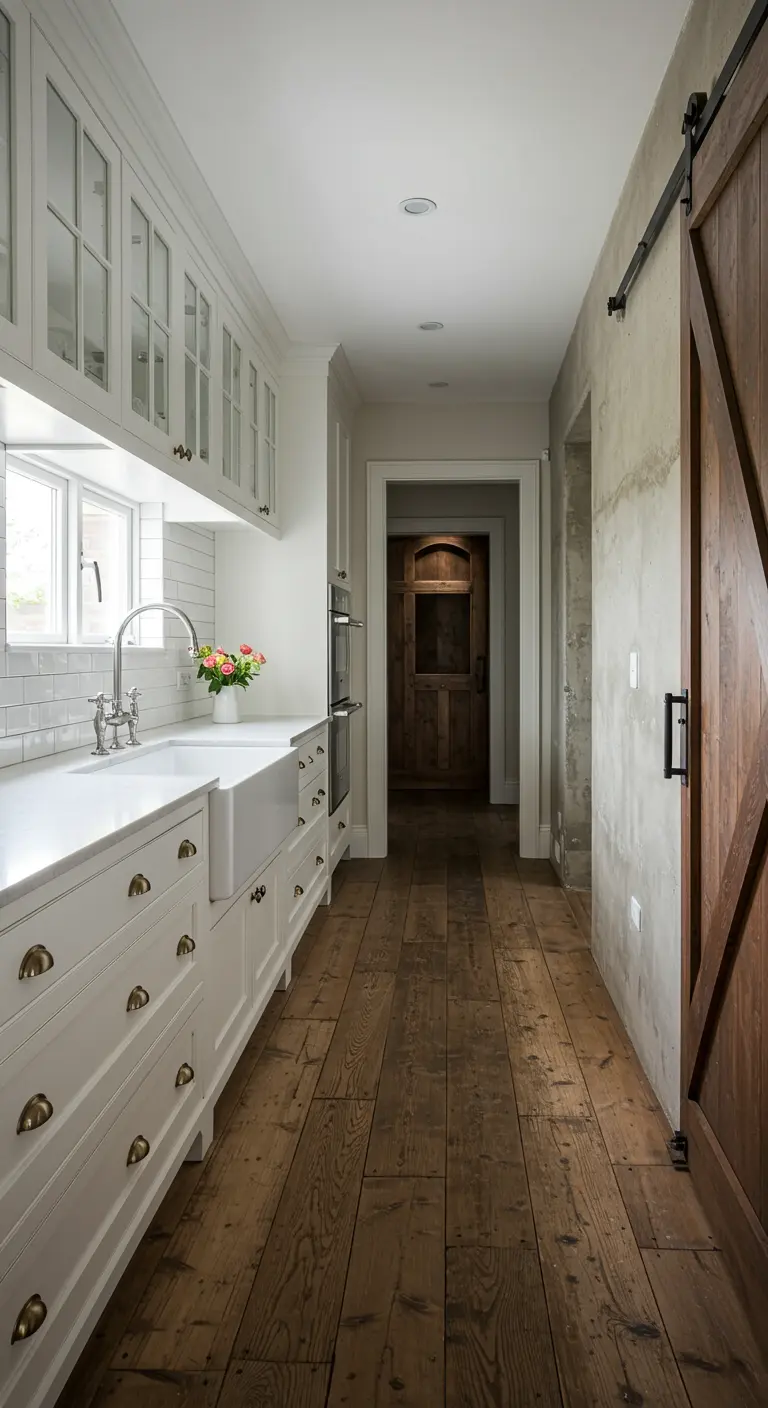
In a galley kitchen or a long, narrow corridor, a traditional swinging door can consume valuable floor space and disrupt traffic flow.
A sliding barn door is a brilliant solution, gliding parallel to the wall without encroaching on the walkway.
Here, it separates the main kitchen from a pantry or hallway, adding a strong, rustic element that contrasts with the refined white cabinetry.
Juxtapose the rustic wood door with a contemporary, unfinished concrete wall to fully embrace the modern rustic hybrid aesthetic.
6. Make Storage a Statement with a Pot Rack
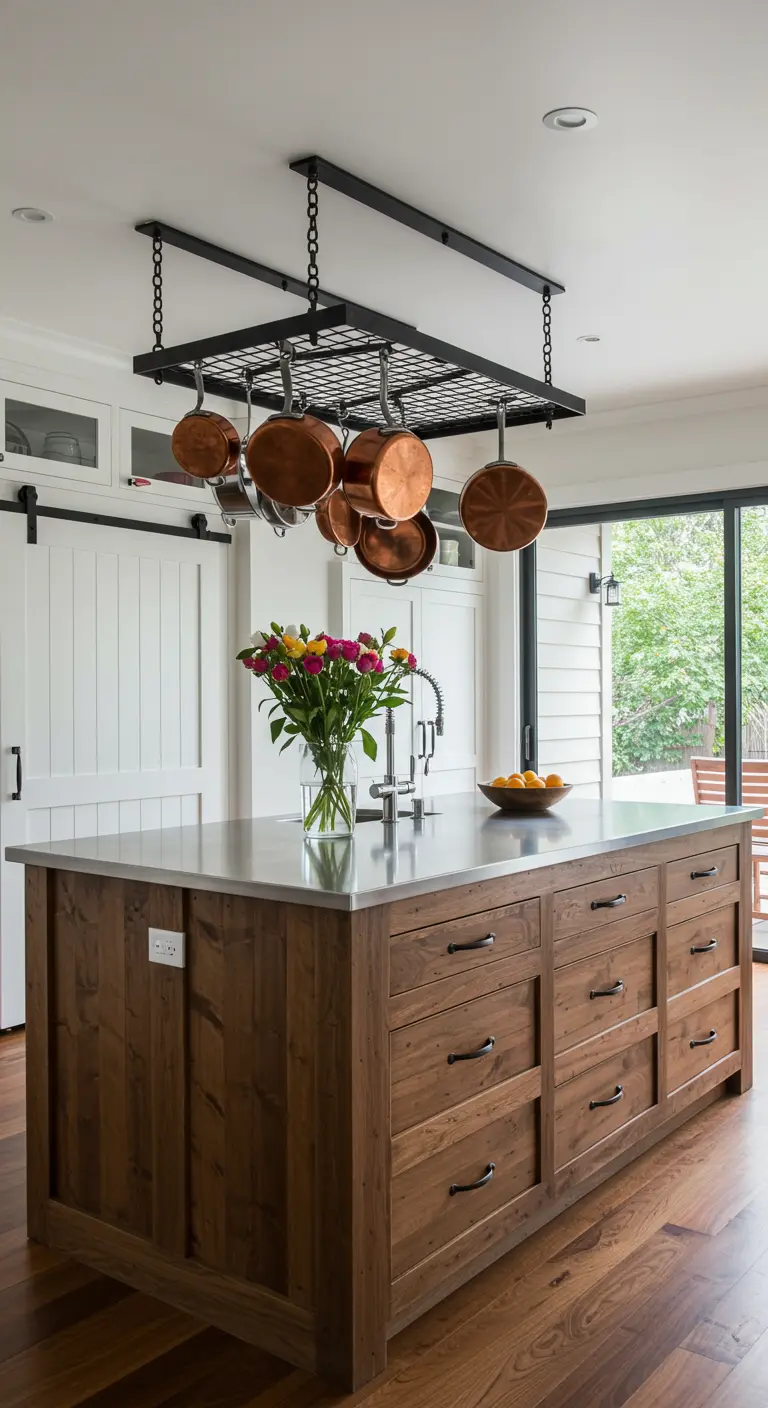
Turn your cookware into a design feature by installing an industrial-style pot rack over your kitchen island.
This not only frees up valuable cabinet space but also adds a strong visual element that speaks to the functional, workshop-inspired side of industrial design.
Choose a rack with a simple metal grid and chain suspension to keep the look authentic.
For a touch of warmth that connects to the farmhouse style, invest in a set of copper or brass pots, which will patinate beautifully over time.
7. Experiment with Unexpected Color Pairings
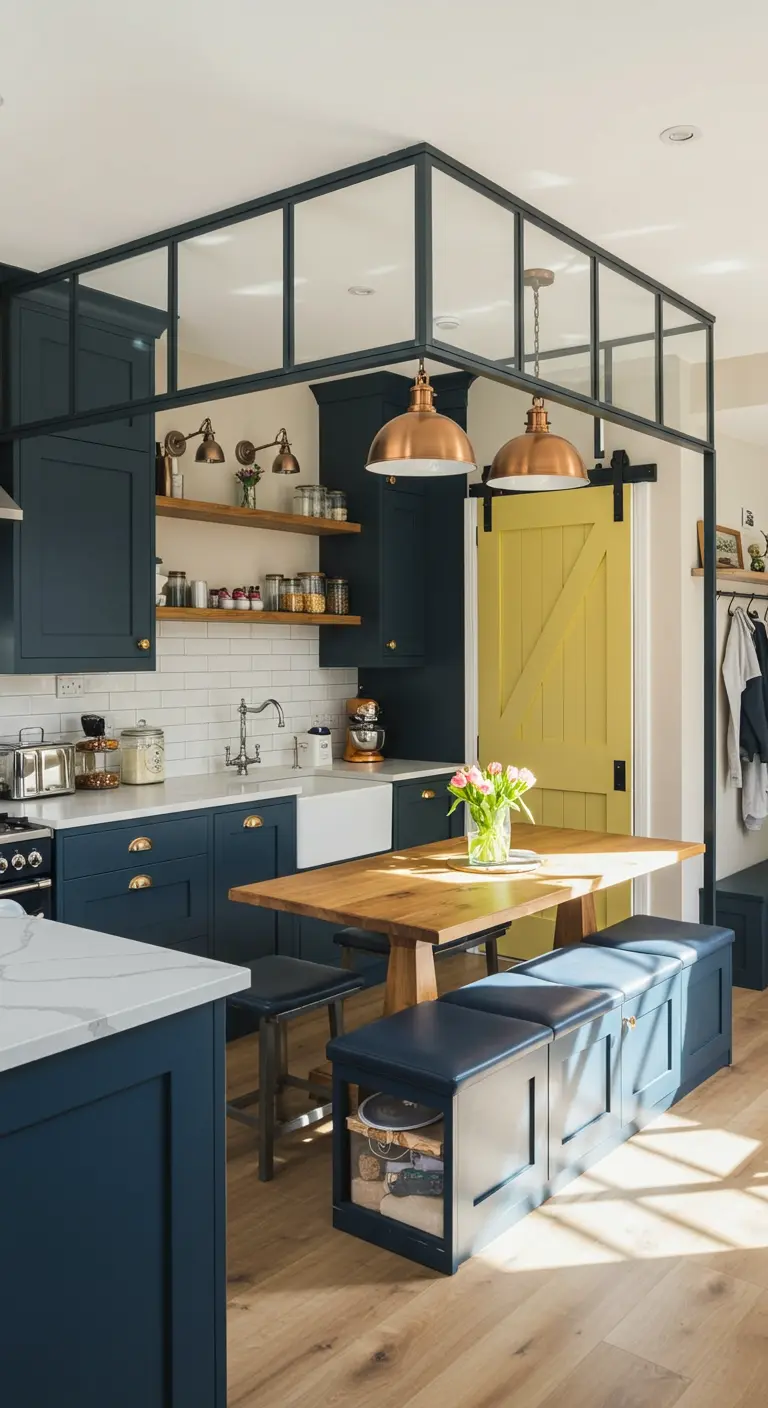
Give your farmhouse-industrial kitchen a unique personality by pairing a classic deep color with an energetic, unexpected accent.
In this space, sophisticated navy cabinets provide a timeless foundation, while a bright, acid-yellow barn door injects a dose of pure joy and modernity.
The key to making this work is confidence and restraint; the yellow is confined to a single, impactful feature.
Copper pendant lights bridge the gap, their warm metallic tone complementing both the cool navy and the vibrant yellow.
8. Scale Your Design for Double-Height Ceilings
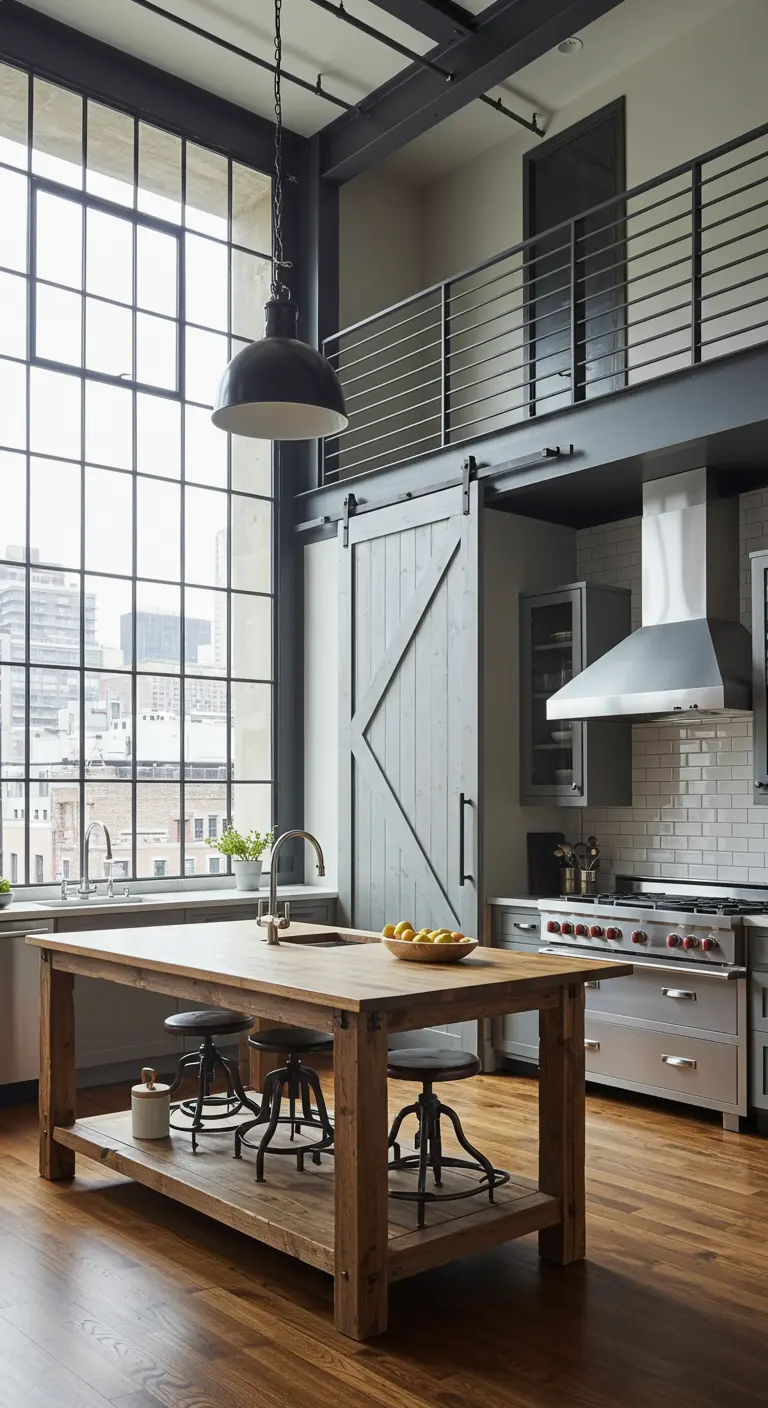
When working with dramatic, high ceilings, your design elements must match the scale of the room to feel balanced.
The oversized, floor-to-ceiling steel-framed windows become the room’s main event, flooding the space with light and offering expansive city views.
An extra-tall barn door, painted a soft gray, mirrors the vertical lines of the windows and draws the eye upward, emphasizing the loft’s impressive volume.
A large, low-hanging industrial pendant over the island helps bring the scale back down to a human level, defining the work area within the larger space.
9. Create Calm with a Tone-on-Tone Palette
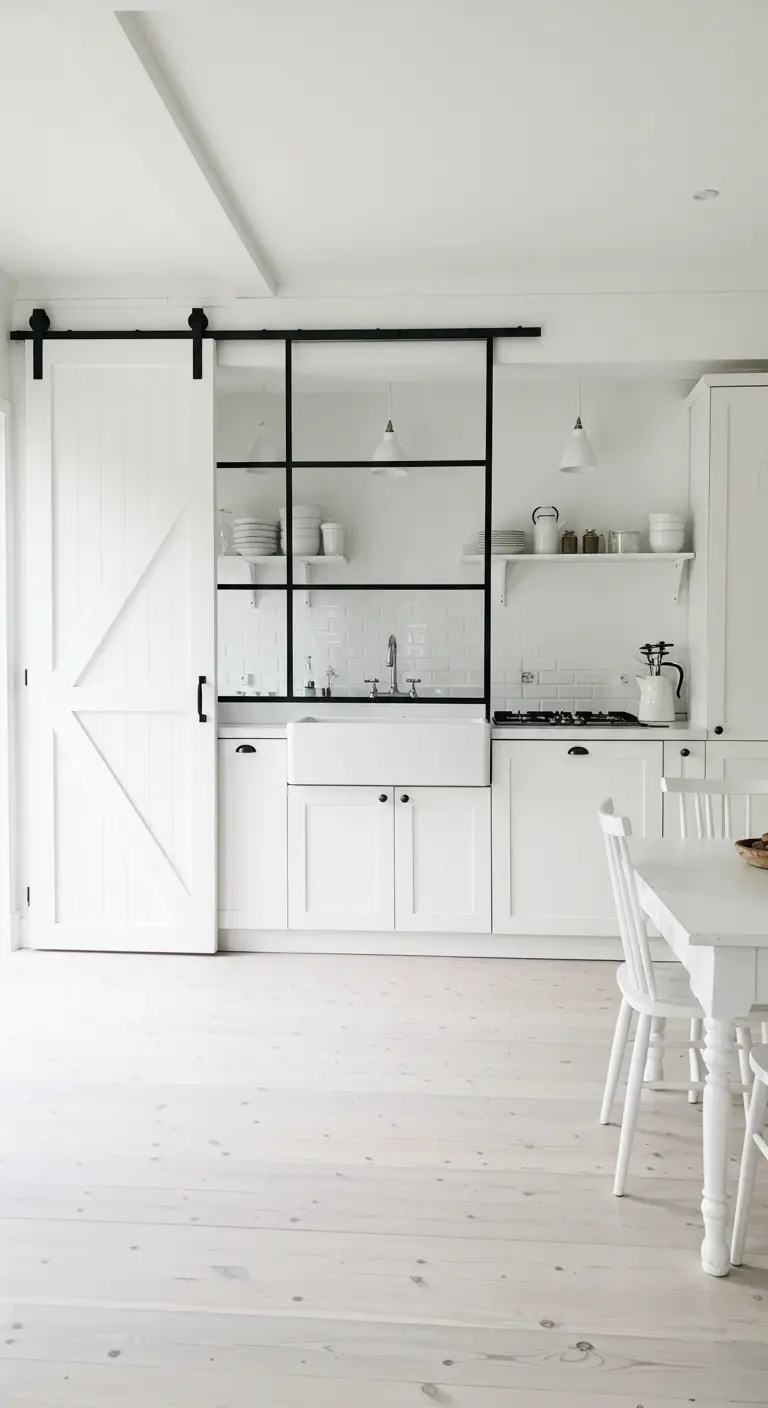
A monochrome white palette can be incredibly serene and impactful, provided you introduce a variety of textures to avoid a flat, sterile look.
Here, the crisp white of the barn door, cabinets, and dining set is given depth by the subtle grid lines of the tile backsplash and the steel-and-glass partition.
The matte black of the barn door hardware provides a sharp, graphic contrast that defines the space.
This approach to high-contrast black & white kitchens feels airy, clean, and intentional.
10. Use a Metallic Backsplash for Subtle Glamour
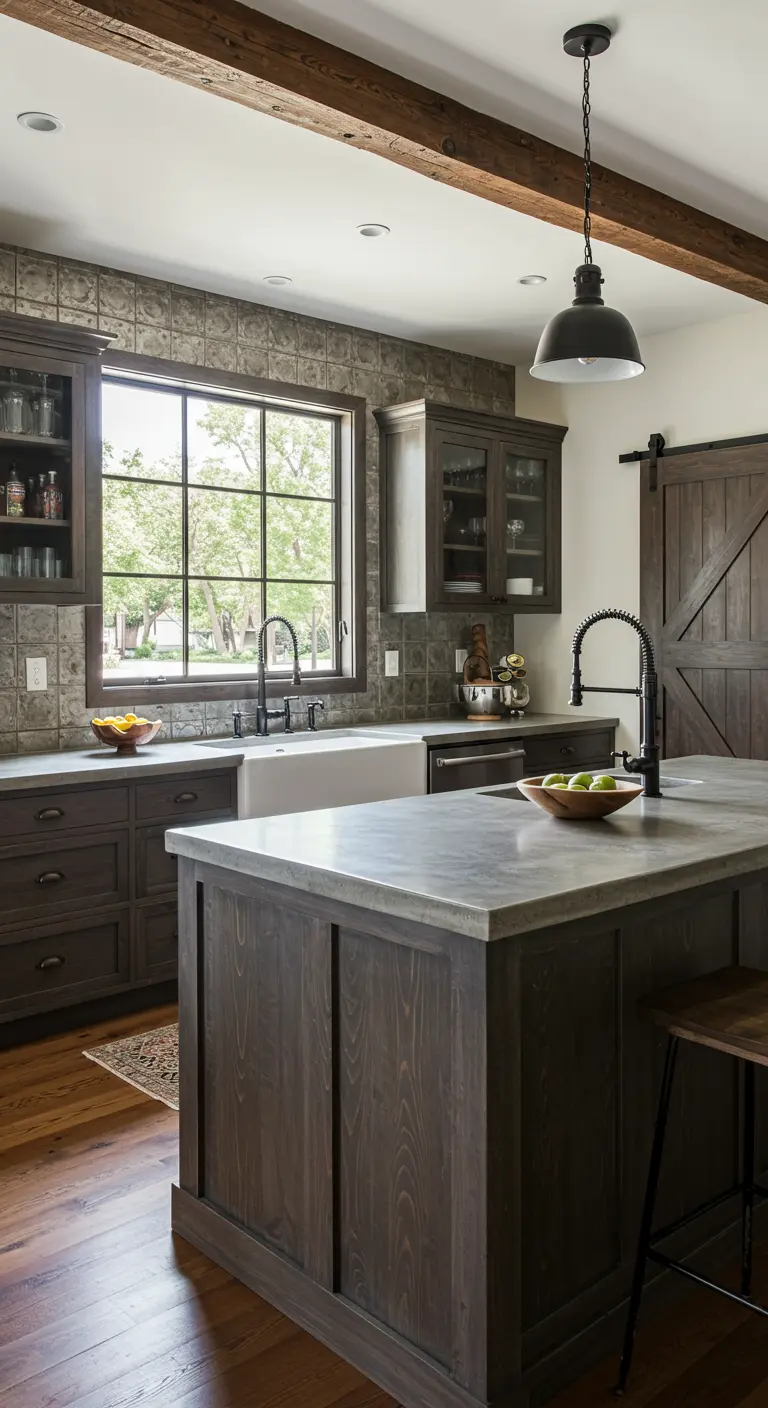
Introduce a layer of texture and light-reflecting quality with a pressed tin or metallic tile backsplash.
This material is a nod to vintage general stores and adds an element of historical charm that bridges the gap between farmhouse and industrial styles.
In a kitchen with dark wood cabinets and concrete countertops, the subtle sheen of the backsplash prevents the design from feeling too heavy.
It catches both natural and artificial light, creating a dynamic surface that changes throughout the day.
11. Designate Zones with a Sliding Door
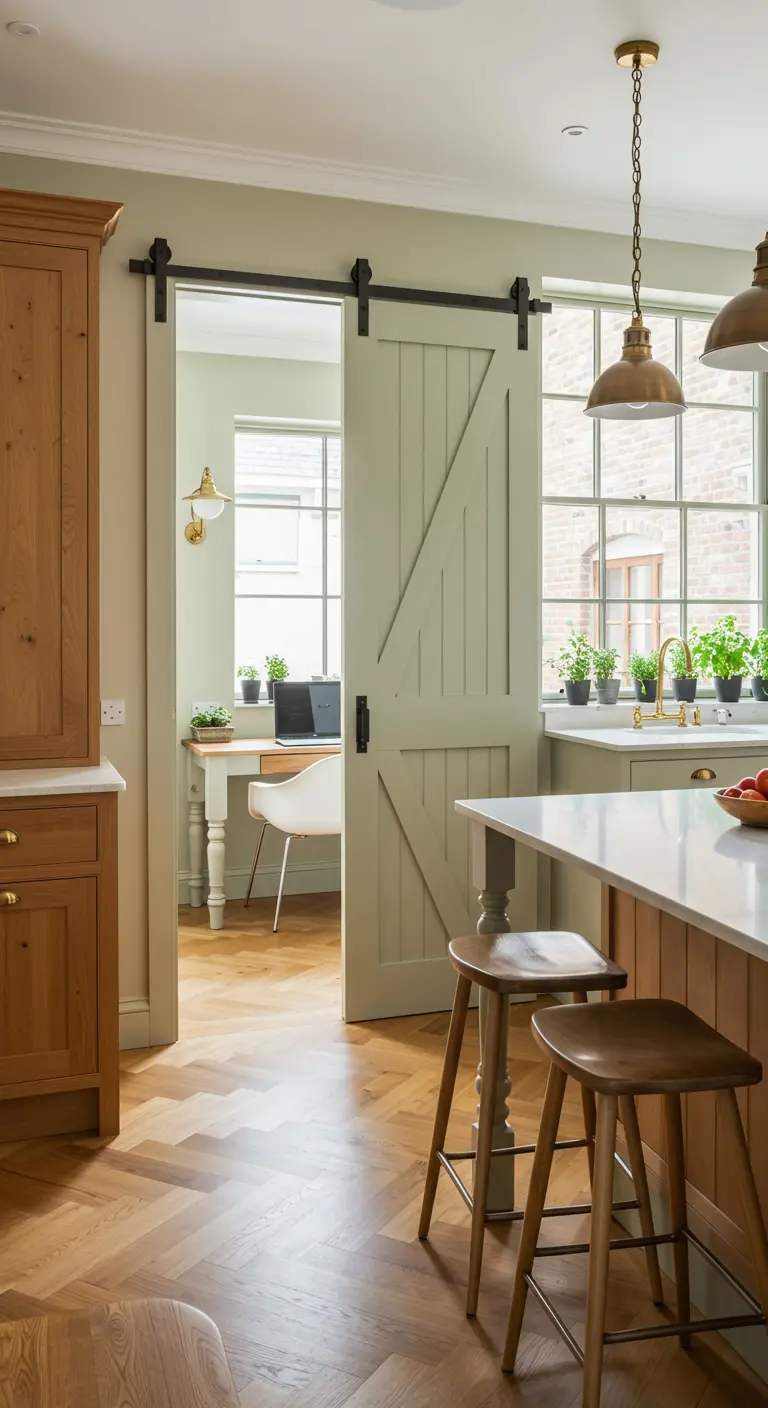
Use a barn door to create a soft, elegant transition between your kitchen and an adjacent space, like a home office or pantry.
Painting the door in a calming, muted color—like this soft sage green—allows it to blend with the wall when closed, creating a seamless look.
This is an excellent strategy for open-plan living, offering the flexibility to close off work or storage areas when you’re entertaining, without the harsh finality of a standard hinged door.
The consistent herringbone wood flooring throughout both spaces ensures the home feels connected, even when the rooms are visually separated.
12. Conceal Functional Spaces in Plain Sight
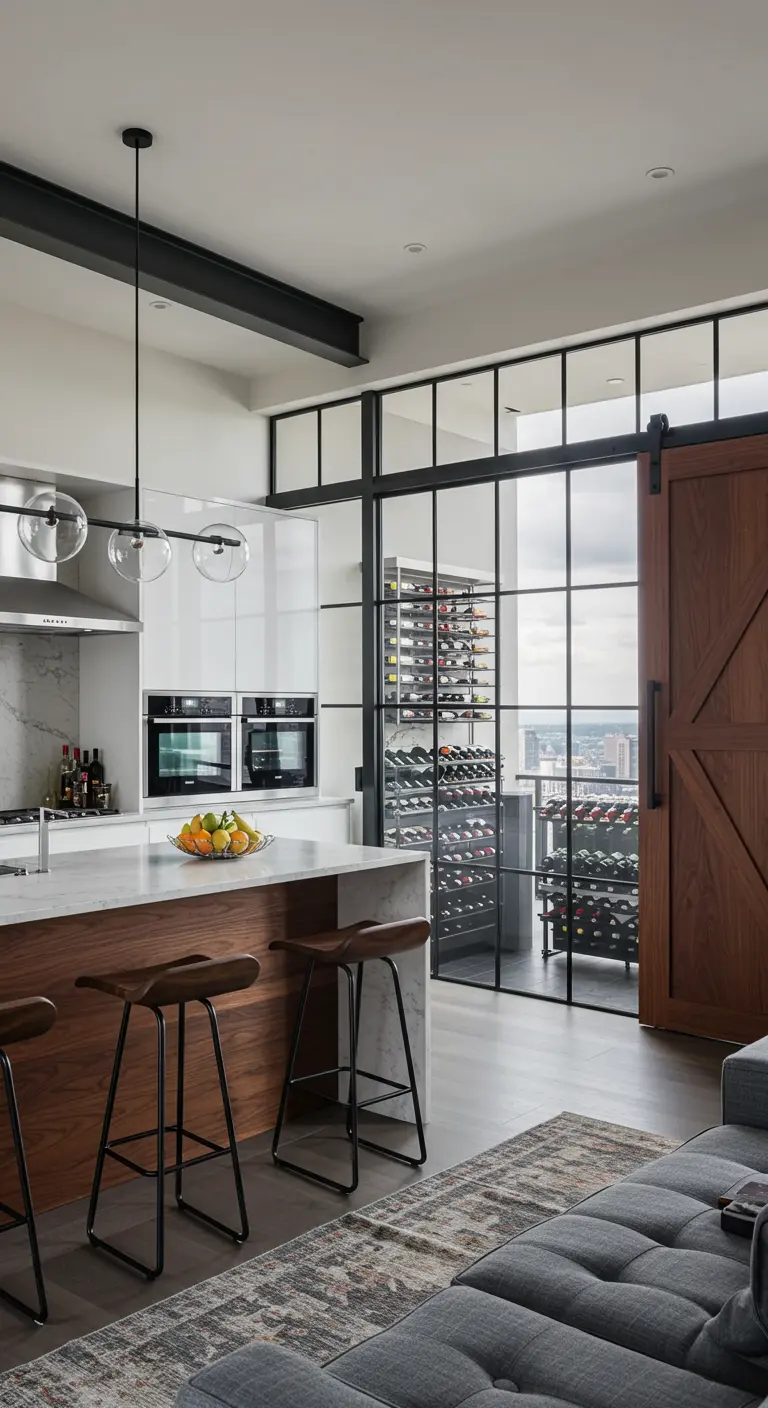
A beautifully crafted barn door is the perfect way to conceal a purely functional space, like a wine cellar or a walk-in pantry, transforming it into a design feature.
Here, the warm wood door slides across a modern, glass-walled wine storage unit, allowing you to choose what’s on display.
This creates a dynamic wall that can shift from a warm, rustic wood feature to a sleek, modern display of your collection.
It’s a perfect example of blending form and function, a core principle of good industrial design.
13. Soften Industrial Bones with Classic Details
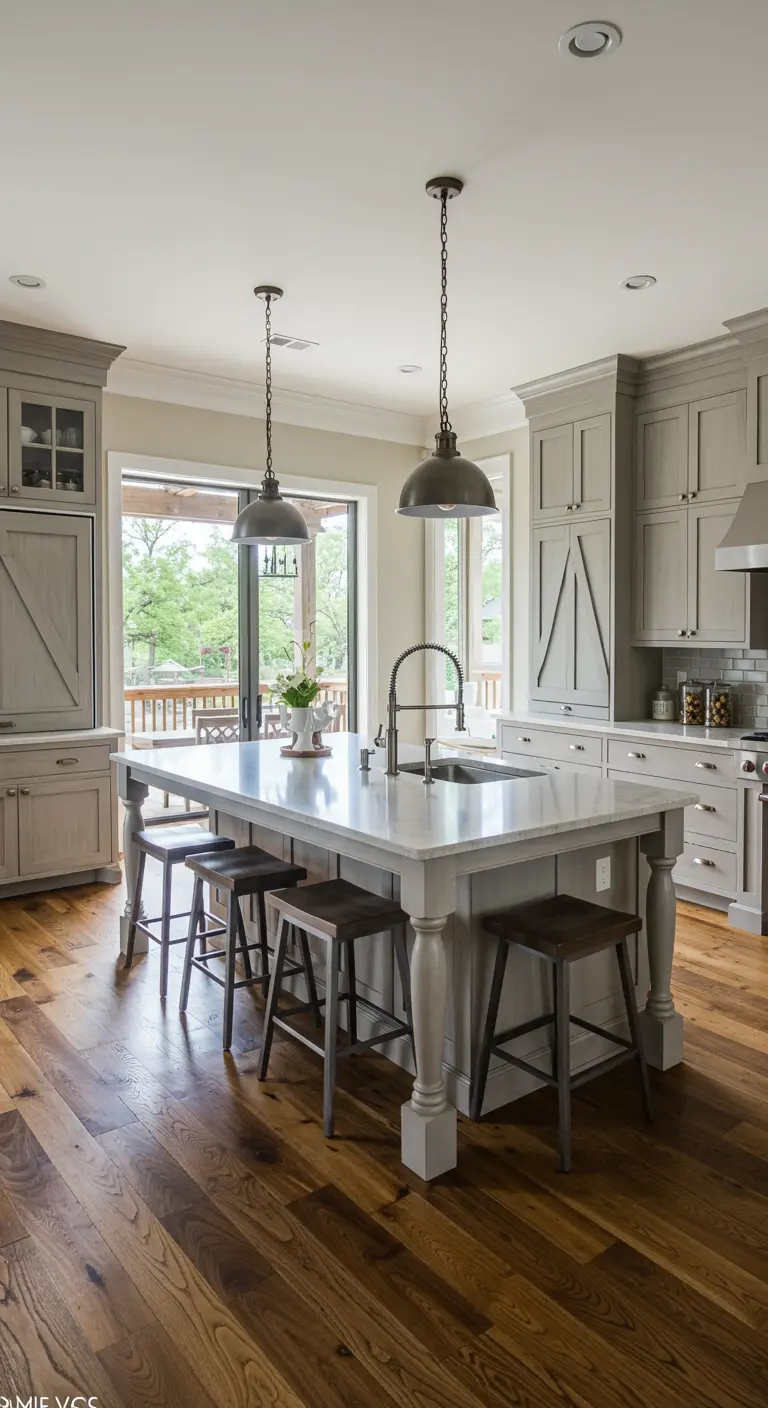
If you love the industrial look but crave more warmth, soften the edges with traditional cabinetry details.
The turned, furniture-style legs on this island and the classic shaker profile of the cabinets add a timeless, handcrafted feel.
These elements, painted in a warm greige, provide a gentle counterpoint to the more industrial dome pendants and metal-and-wood stools.
This thoughtful mix ensures the space feels established and welcoming, not stark or cold.
14. Frame a View with an Arched Window
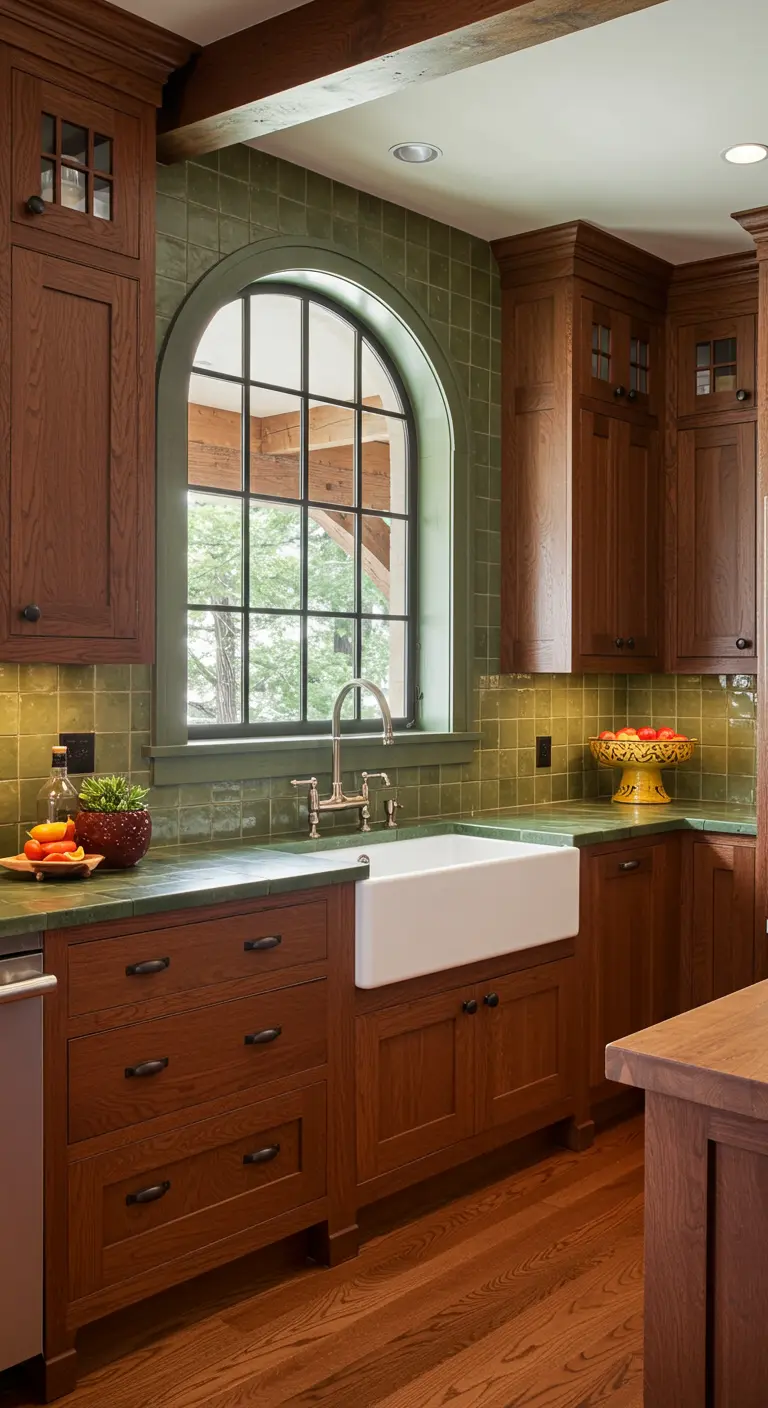
Introduce a soft, organic shape into your kitchen to balance the hard lines of cabinetry and tile.
An arched window, especially one with strong black mullions, acts as a stunning architectural focal point.
It draws the eye, frames the outdoor view like a living piece of art, and adds a touch of classical elegance to the rustic space.
Paired with earthy green tile and warm wood cabinets, the arch creates a grotto-like feeling that is both grounding and uplifting.
15. Personalize Your Space with an Artistic Door
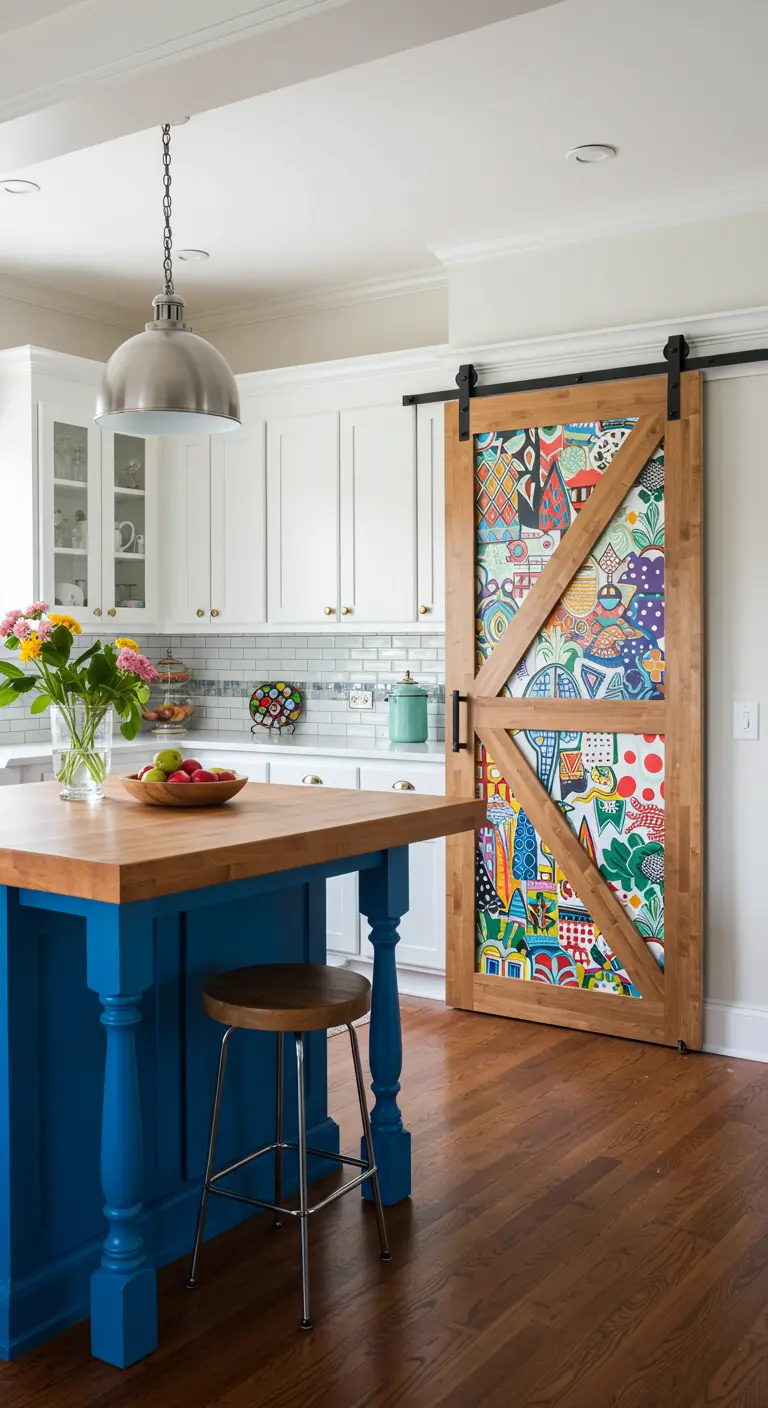
Treat a barn door not just as a functional object, but as a canvas for personal expression.
Instead of a solid wood or painted finish, consider adding custom panels featuring wallpaper, fabric, or even a mural, as seen in this vibrant example.
This is a fantastic way to inject bold color and pattern into your kitchen without the commitment of tiling a full wall.
It turns a standard architectural element into a unique piece of art that tells a story and is completely your own.
16. Make the Window Your Kitchen’s Centerpiece
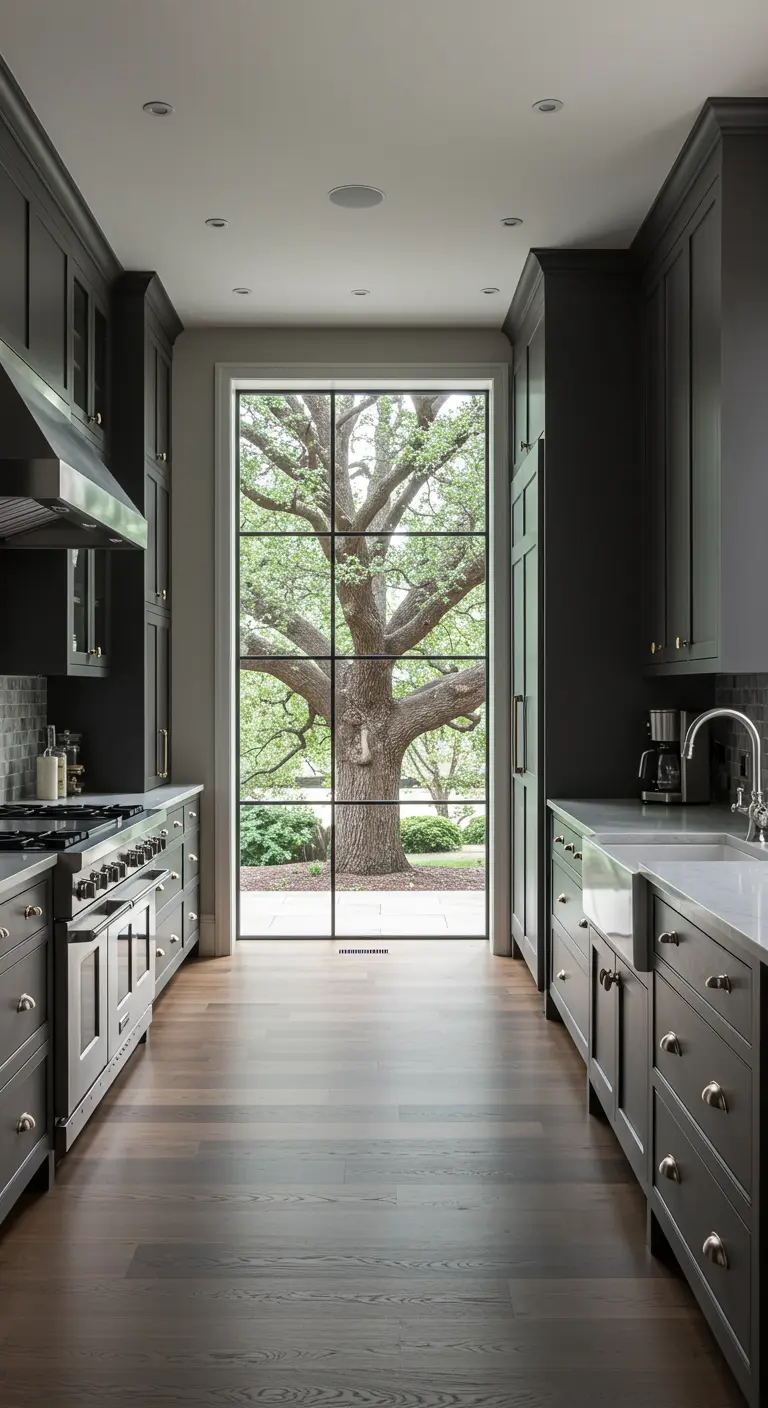
Design your kitchen layout to celebrate, rather than compete with, a beautiful view.
By flanking a large, floor-to-ceiling window with symmetrical, dark-painted cabinetry, you create a powerful frame that turns the outdoor scenery into the room’s main artwork.
This technique draws the eye directly to the light and nature outside, making the entire space feel larger and more connected to its surroundings.
Keeping the surrounding finishes simple and understated ensures the view remains the undisputed star.
17. Choose a Sink with Character and Patina
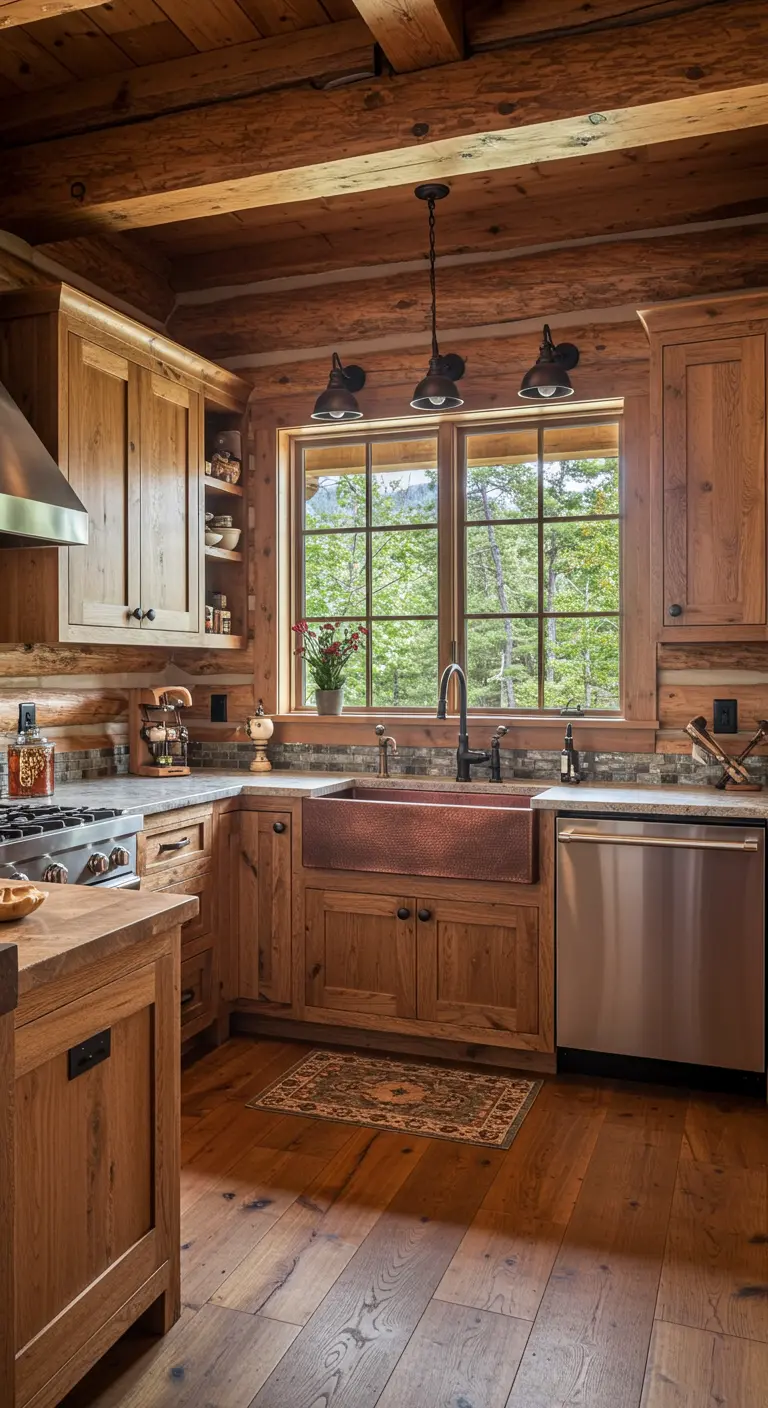
In a rustic kitchen rich with natural wood, elevate your design by choosing a sink material that contributes to the aesthetic.
A hammered copper farmhouse sink is a perfect choice, offering a warm, metallic glow that complements the tones of the wood.
Unlike sterile stainless steel, copper develops a unique patina over time, a living finish that deepens in character with use.
This choice reinforces the handcrafted, timeworn appeal that is central to the rustic style.
18. Use Fluted Glass for Privacy and Texture
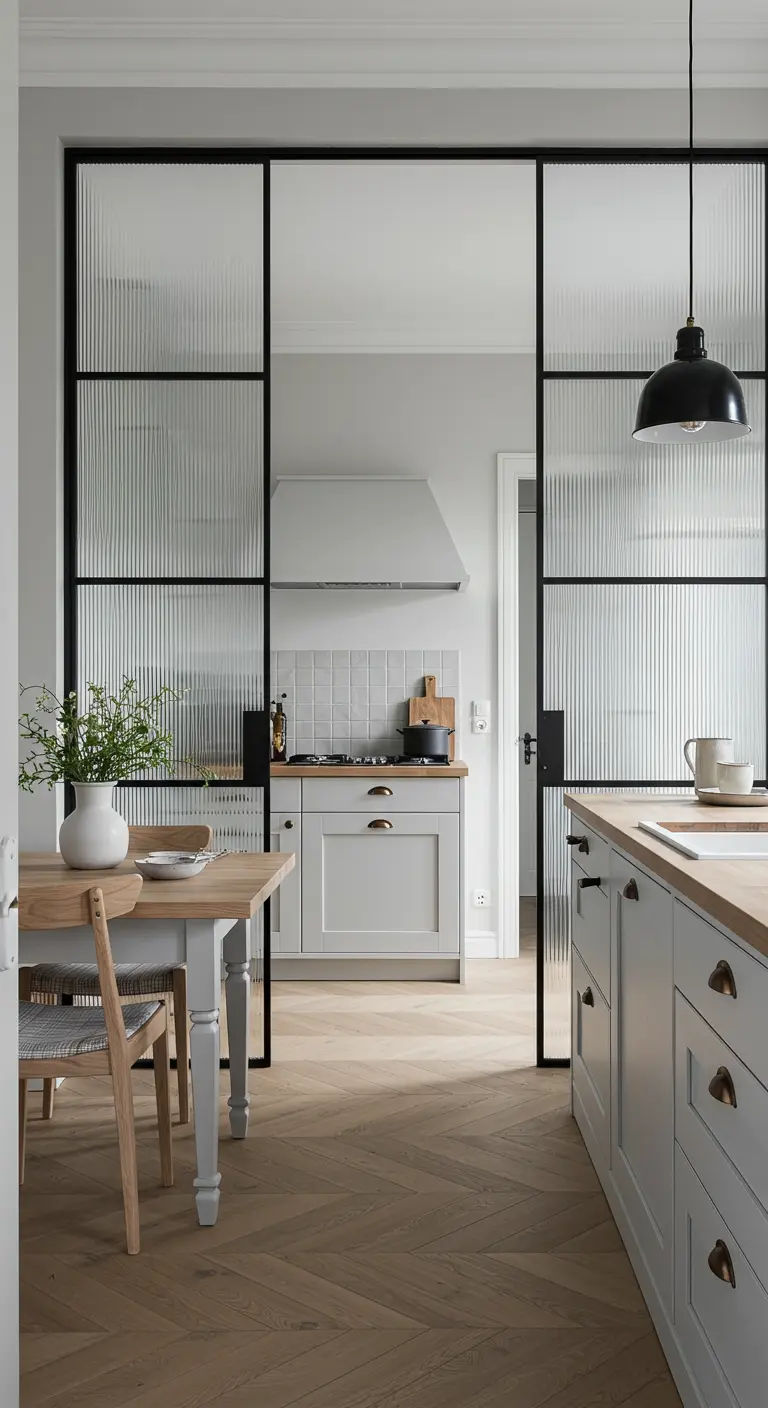
For interior partitions or doors, consider fluted or reeded glass as an alternative to standard clear panes.
Set within a black steel frame, this textured glass offers a degree of privacy by obscuring direct views while still allowing light to pass through freely.
The vertical ridges add a subtle, sophisticated pattern that catches the light beautifully, creating a sense of movement and depth.
It’s a perfect way to add a touch of Art Deco elegance to an industrial framework.
19. Weave in a Retro Color for Playful Contrast

Don’t shy away from mixing design eras to create a kitchen with layered personality.
The rustic, unfinished wood of the barn door provides a beautiful, earthy contrast to the cheerful, retro mint green of the cabinets and appliances.
This pairing works because it’s grounded by classic elements like the black-and-white checkerboard floor and simple white subway tile.
The result is a space that feels personal and collected over time, rather than decorated in a single, rigid style.
20. Balance Professional Appliances with Soft Finishes
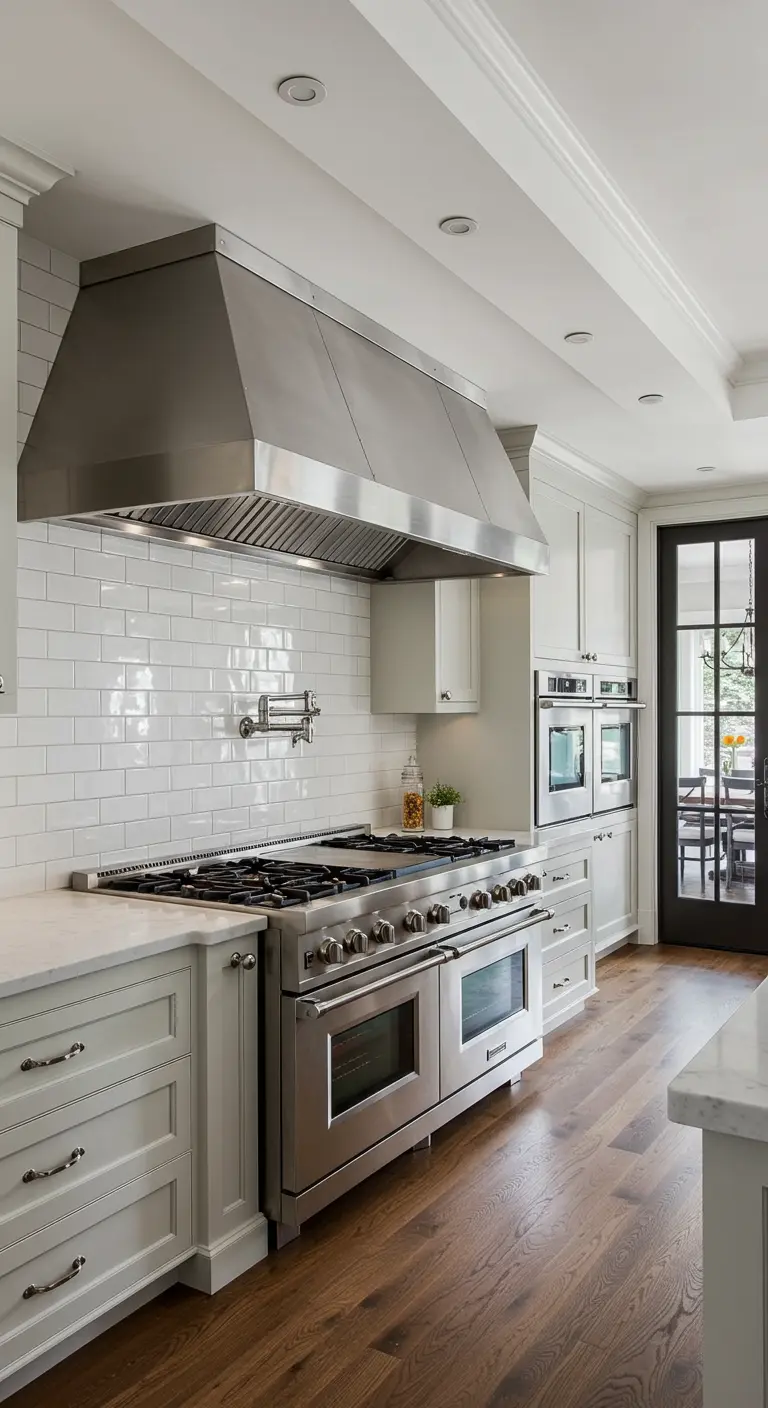
If you opt for a commercial-grade range and a statement stainless steel hood, balance these powerful industrial elements with softer touches.
Warm wood floors, classic shaker cabinets painted in a gentle off-white, and traditional hardware prevent the space from feeling like a restaurant kitchen.
A gleaming white subway tile backsplash provides a clean, bright backdrop that ties the modern stainless steel and classic cabinetry together.
This thoughtful mix gives you professional-level function within a warm, inviting home environment.
21. Layer Raw Textures for an Authentic Loft Feel
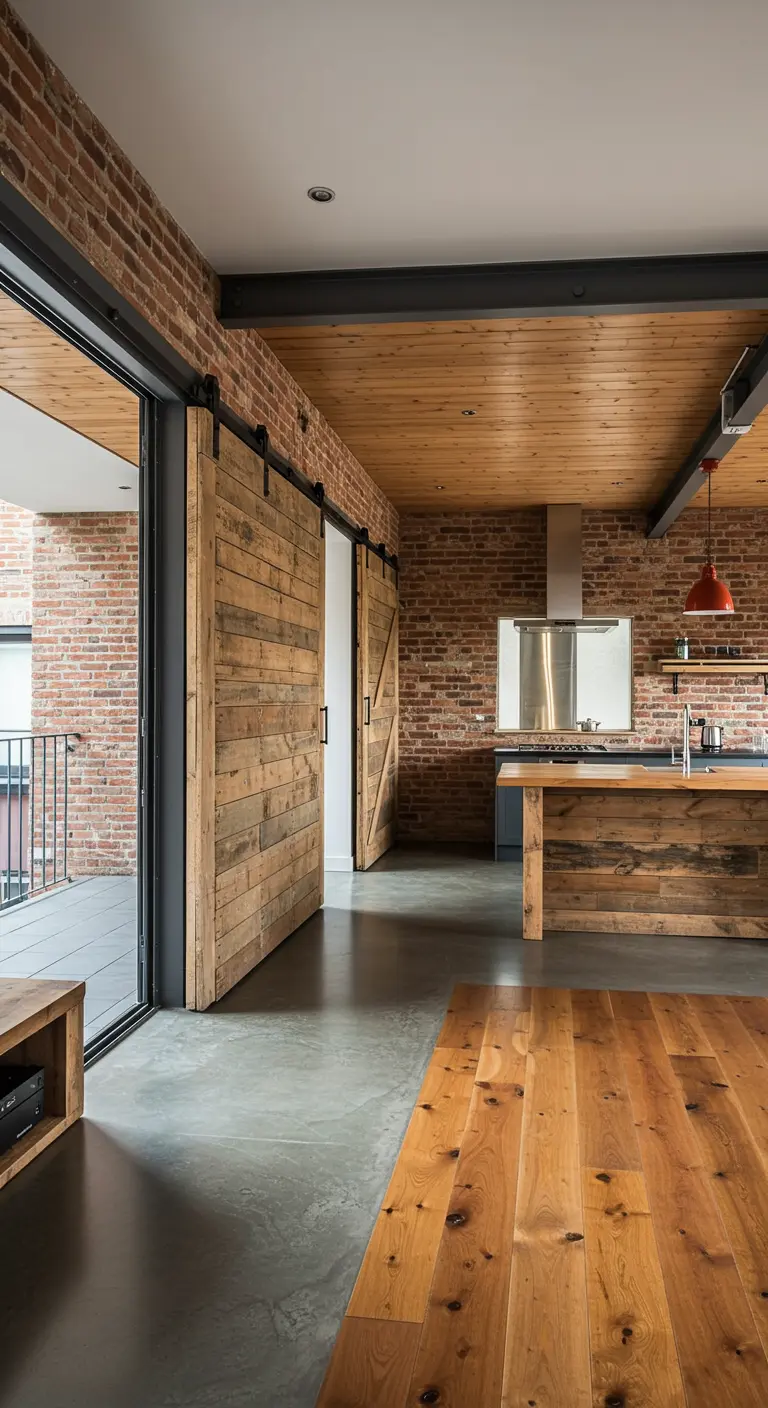
To achieve a truly authentic industrial loft aesthetic, embrace a philosophy of layered, honest materials.
Don’t just choose one raw element; combine several. Here, the rough-hewn reclaimed wood of the sliding doors plays off the smooth, cool concrete floor.
Exposed brick walls add another layer of history and texture, while the natural wood plank ceiling brings warmth to the entire volume.
This confidence in raw materials creates a space that feels structurally honest and deeply rooted in its industrial heritage.
22. Soften Industrial Grids with Living Greenery
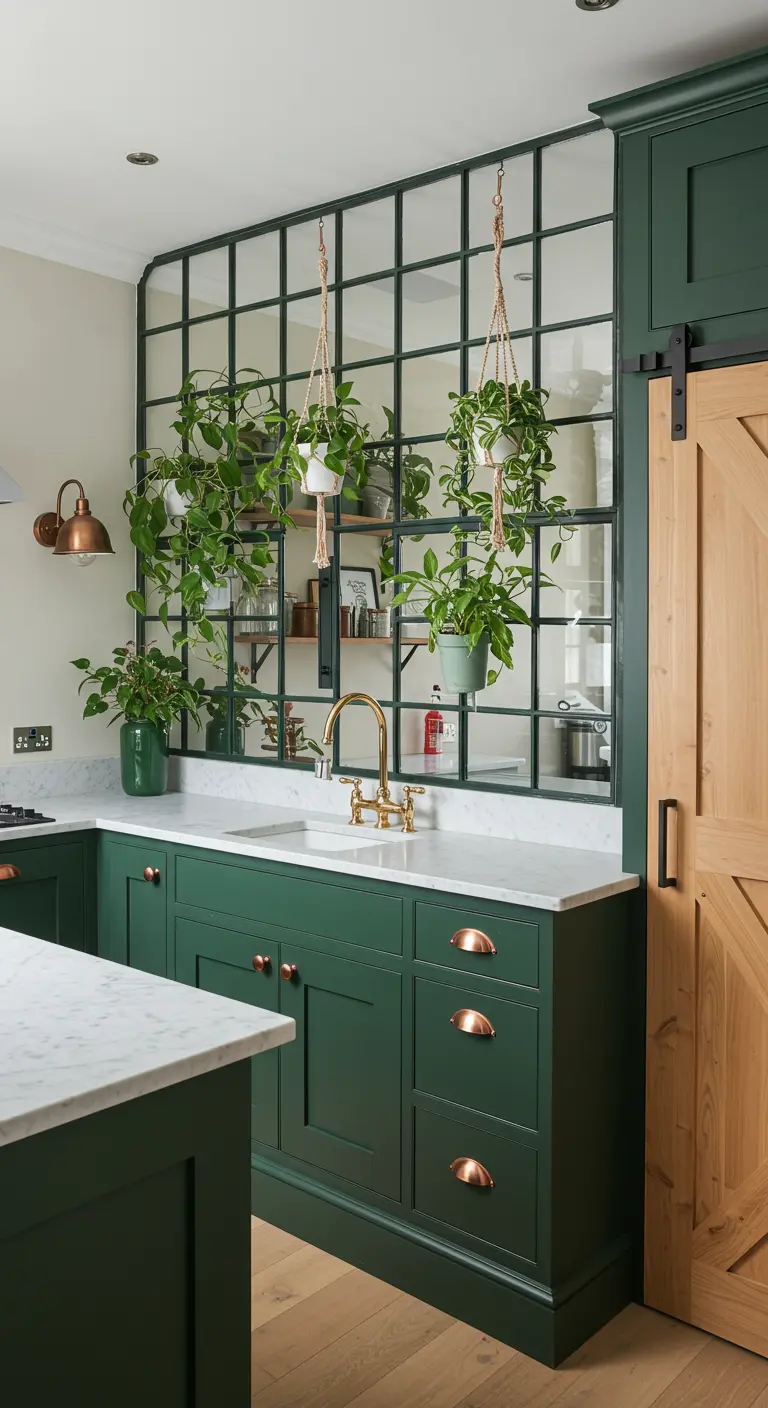
A steel-and-glass wall is a hallmark of industrial style, but it can feel severe on its own.
Soften its rigid geometry and bring life into your kitchen by introducing an abundance of hanging and potted plants.
The organic, trailing shapes of the vines create a beautiful contrast against the straight black lines of the frame. Green-infused kitchens feel vibrant and fresh.
Using simple macrame hangers adds another layer of soft, handcrafted texture that ties into the farmhouse side of the design fusion.
23. Create Graphic Impact with High-Contrast Blocking
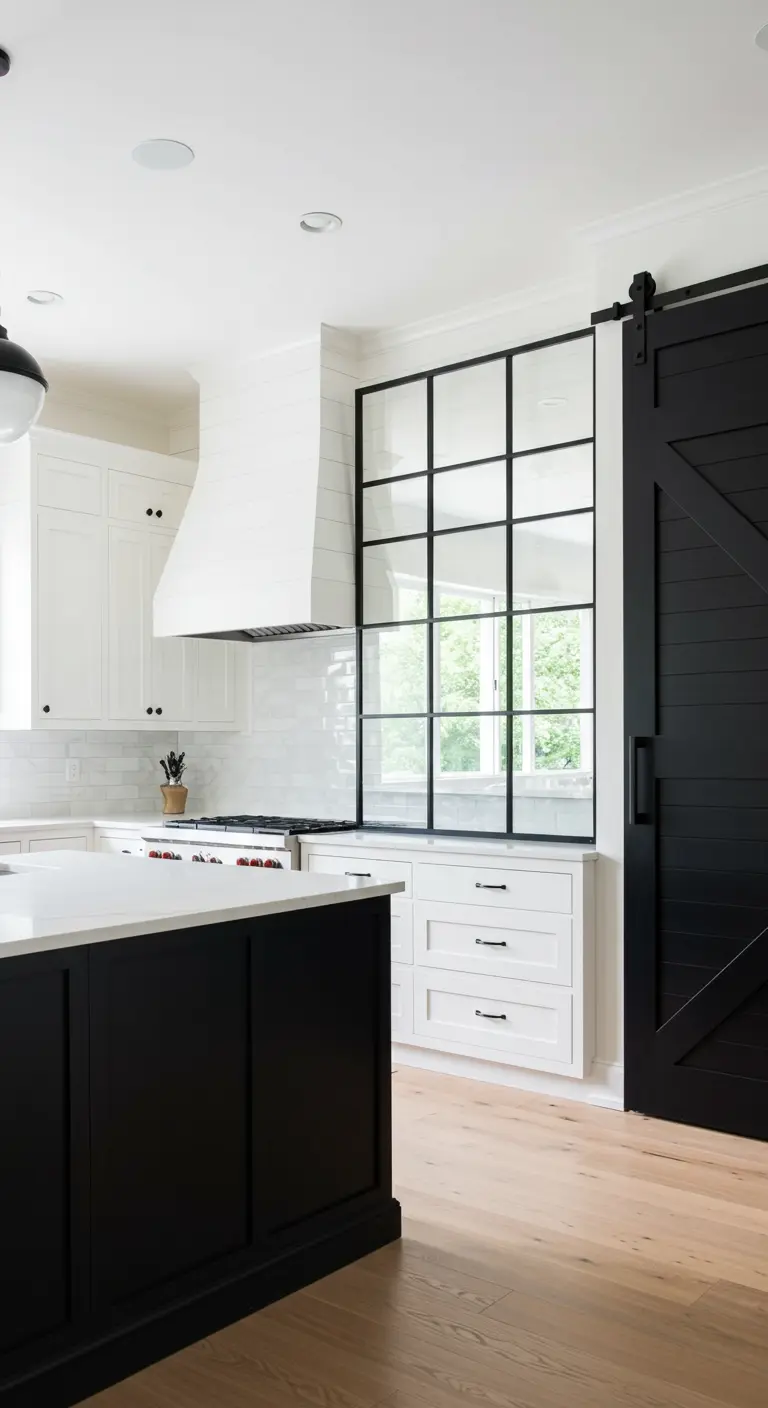
For a clean, bold, and modern take on the farmhouse-industrial style, use a disciplined black-and-white color palette.
Commit to strong color blocking: a solid black island and a matching black barn door create powerful, graphic shapes against crisp white walls and cabinets.
The black-framed window echoes this theme, tying the elements together. Keeping the hardware minimal and also black maintains the clean, graphic quality.
This approach is dramatic yet simple, relying on form and contrast rather than ornamentation.
24. Use Pendant Lighting to Define Your Island
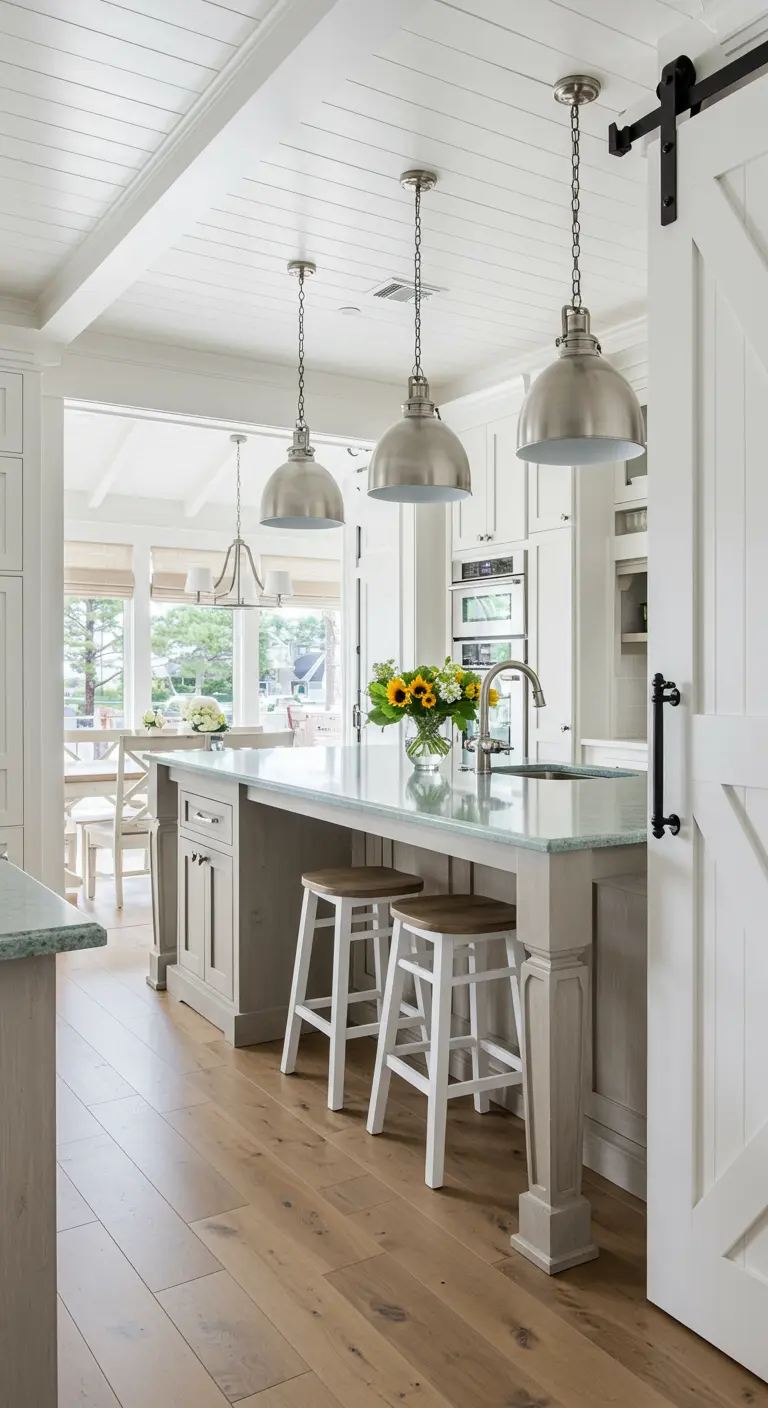
A trio of well-chosen pendant lights does more than just illuminate your workspace; it defines the island as the kitchen’s anchor.
These brushed nickel dome pendants have an industrial feel, but their soft, metallic finish prevents them from looking too heavy in this light and airy, coastal-inspired space.
Hanging them in a row creates a strong visual line that emphasizes the length of the island and draws people in.
Always consider the scale: the size of your pendants should be proportional to the size of your island for a balanced look.
25. Contrast Cabinet Finishes for a Dynamic Look
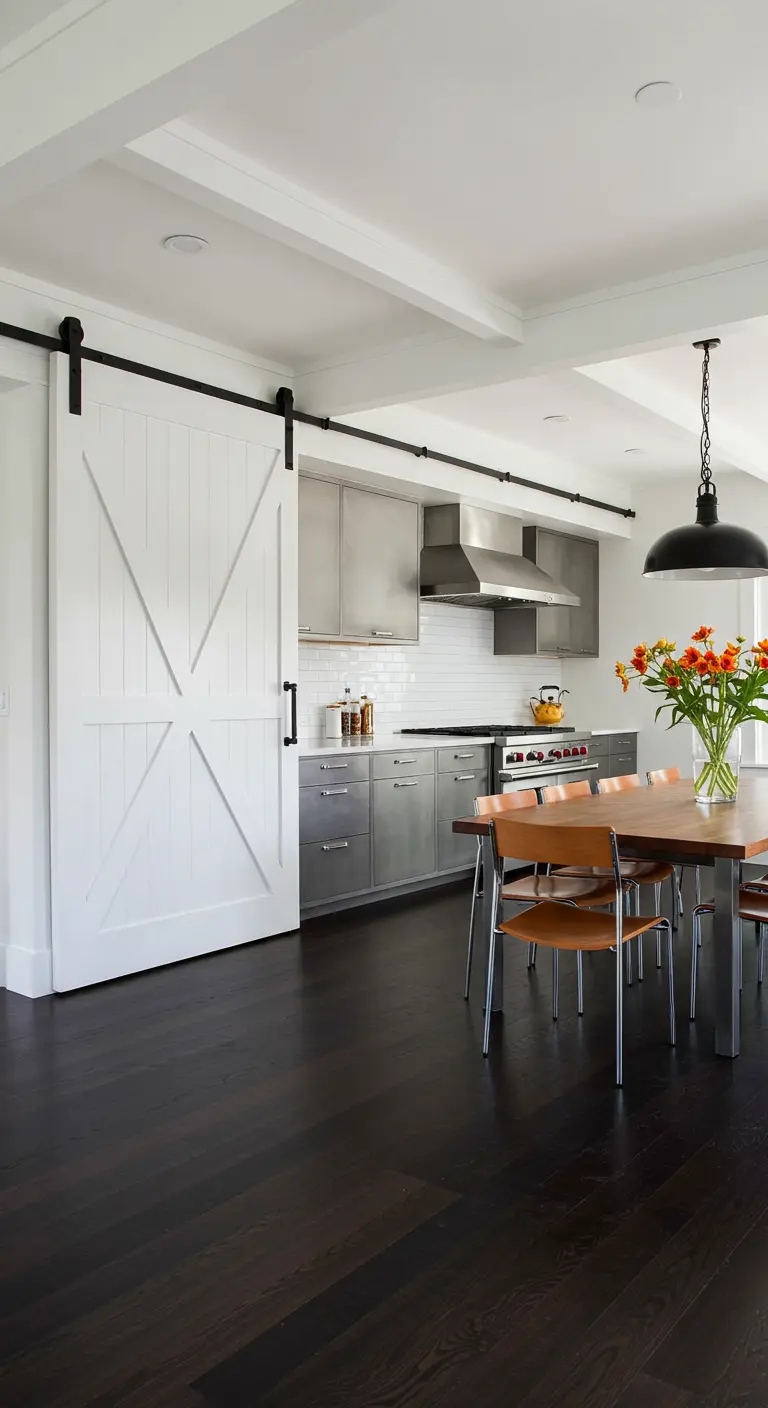
Create visual tension and interest by pairing two very different cabinet finishes in your kitchen.
Here, the sleek, cool feel of stainless steel base cabinets and appliances offers a distinctly industrial, almost commercial vibe.
This is immediately balanced and warmed by the large, classic white barn door and simple white subway tile backsplash.
This bold contrast works because the rest of the palette is kept simple, allowing the materials themselves to be the focus.
26. Craft an Atmospheric Space with Stone and Wood
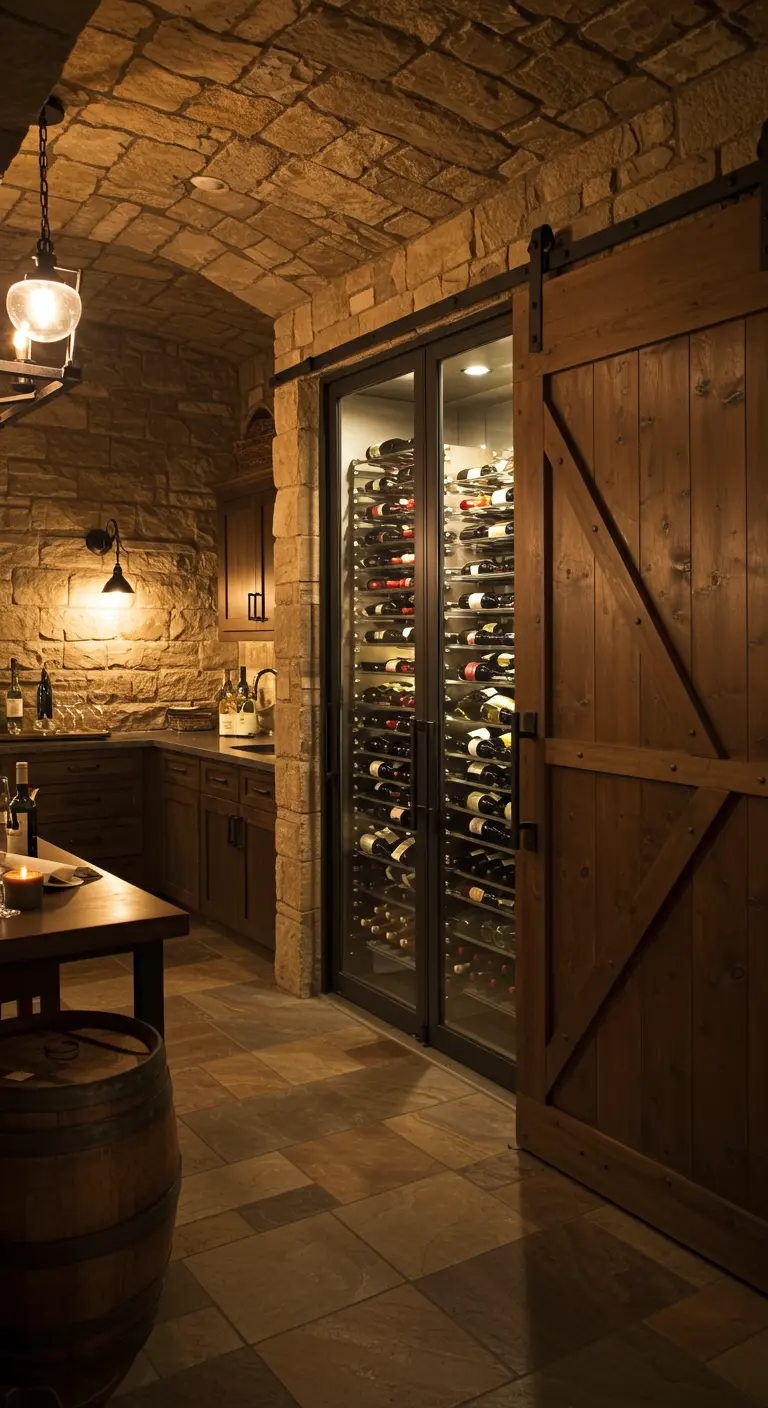
For a wine cellar or bar area, lean into a moody, rustic aesthetic by combining rough-faced stone walls with warm wood.
The texture of the stone, especially on an arched ceiling, creates a cavelike, subterranean feel that is perfect for cellaring wine.
A sturdy, dark-stained barn door enhances the sense of entering a special, hidden place.
Warm, low-level lighting from sconces and pendants is crucial here, highlighting the textures and creating an intimate, glowing ambiance.
27. Add a Touch of Whimsy with a Chalkboard Door
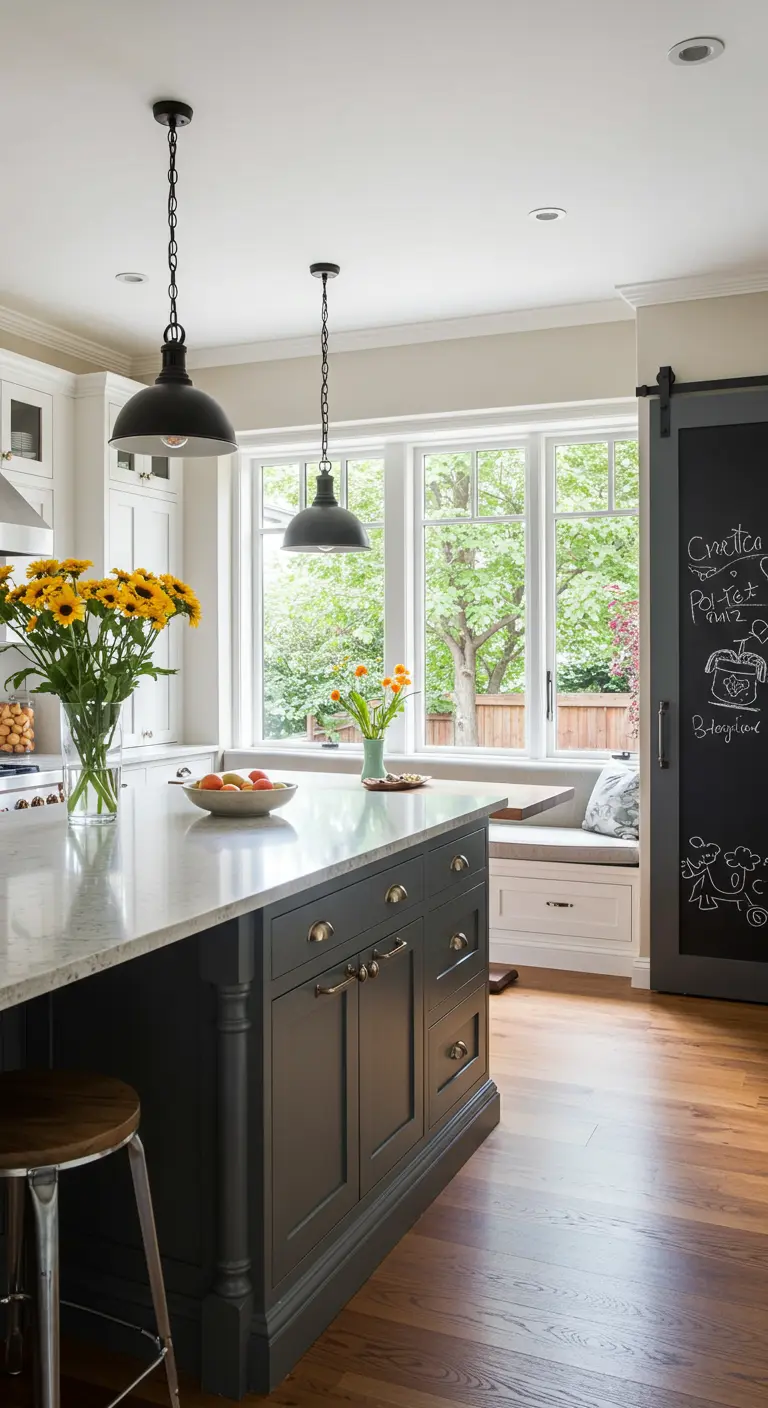
Make your barn door a hub of communication and creativity by finishing it with chalkboard paint.
This is a wonderfully practical and charming addition to a family kitchen, perfect for jotting down grocery lists, daily menus, or sweet messages.
It turns a simple door into an interactive feature that constantly changes.
Placing this functional element next to a cozy window seat creates a corner that is all about comfort, function, and family connection.
